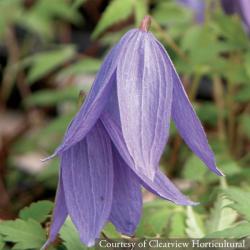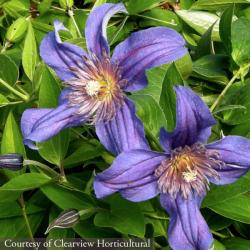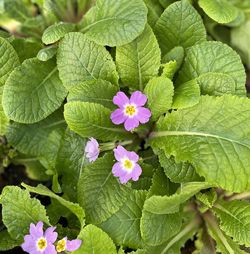Including Clematis, Hydrangea, & Schizophragma
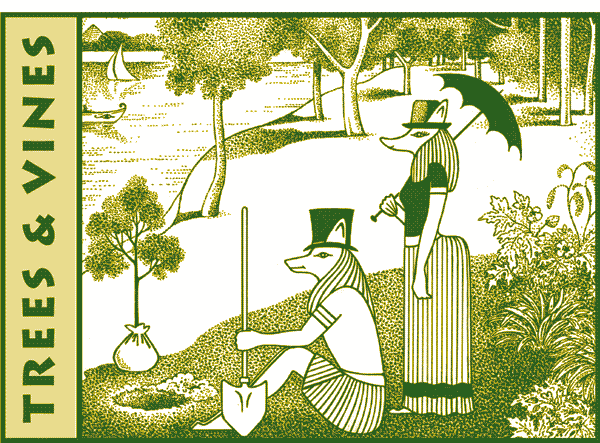
If gardens are outdoor rooms, designed to create a sense of enclosure, then trees are the pillars or columns that support the walls and ceiling. No wonder there are so many tree worshipers.
Trees are permanent legacies to the future; even if your plot of ground isn't an estate, you can leave something of enduring beauty behind. Use them to block unsightly views or to frame and emphasize outstanding ones. Only trees can give a garden that certain satisfying sense of permanence and maturity. Their shade and dappled light create microclimates beneath.
Plant trees singly as a starring role specimen, use three or five to create a grove, or get carried away and plant a French allée with double or multiple rows paralleling a central corridor. If your property is blessed with some ancient specimens, remember that they won't last forever, and plant a new generation with that in mind. However you decide to use them, do plan your garden around trees.
Vines are amazing in their ability to lend an air of maturity to the garden; trained on fence, arbor, pergola or house, they can frame a distant vista or intimate view. Vines can be used to “ground” any structure to the earth, and are perfect for harmonizing architectural forms with the environment. They can visually soften stone walls and fences, and even camouflage an unsightly feature. Select a vine for its delicacy of pattern and leaf shape, or choose a veritable cascade of blossom.
Acer
Maple
Each $28.00
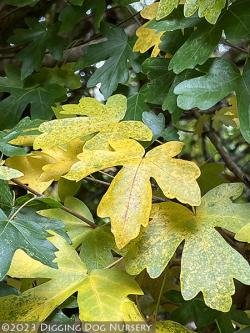
Named after the famed European hedgerows and magnificent living walls it forged hundreds of years ago, this versatile low-branched AGM champion develops a small, domed close-knit habit dressed in opposite polished dark green leaves with 3 to 5 rounded lobes. Heroically tackling urban conditions, heavy clay and wind, Acer campestre’s no-nonsense deciduous mettle is more acquiescent to hot weather and dry alkaline soil than most in the genus. Though Hedge Maple responds well to clipping, it can also be grown as a large multistemmed shrub, bushy lawn specimen or handsome long-lived street tree, while offering additional enticements: winged fruit, buttery-yellow fall color, bird and pollinator support plus corky, furrowed sable-toned branches for winter interest. Fast growing. Large Band.
Blooms April–May
Size: 25' 0" – 35' 0" high x 25' 0" – 35' 0" wide.
Hardy to zone 5.
Each $29.50
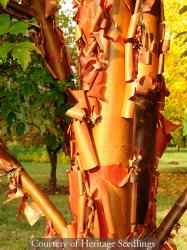
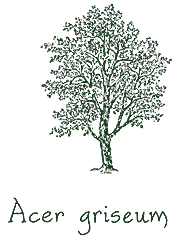
With a dignified, rounded form, dramatically flaking mahogany-colored bark that peels to expose the cinnamon hues beneath, and rich green trifoliate leaves that blaze to a brilliant red each fall, China’s Paperbark Maple is a splendid specimen for just about any place in your garden. This Maple requires well drained soil, and will tolerate sun, shade or wind, but never drought. Unparalleled for its winter beauty, Acer griseum grows slowly to its full size.
Large Band.
Size: 20' 0" – 30' 0" high x 15' 0" – 20' 0" wide.
Hardy to zone 4.
Actinidia kolomikta ‘Arctic Beauty’ (T-0003)
OUT OF PRODUCTION AT THIS TIME
Email me when this plant is available
With a name that sounds like a magical chant, this deciduous climbing vine extends the Kiwi’s hardiness range into the Northern U.S. and Canada. Its 3 to 5 in. heart-shaped leaves are painted with creamy white, green and pink. In summer, it bears small white flowers without fruiting.
Give this charmer well drained soil and watch it ramble up a pergola, fence or wall. Grant up to 2 to 3 years for the striking variegation to appear. Grows rapidly. Large Band.
Blooms June.
Size: 15' 0" high x 0" wide.
Hardy to zone 4.
Amelanchier alnifolia ‘Smokey’ (T-0322)
Each $17.75
Prized for its larger-than-average glossy purplish blue fruit, impressive cold hardiness and superb ornamental aspect, this versatile western and central North American denizen grows as a large multistemmed shrub or small, branching deciduous tree. Clustered self-fertile white flowers muster a sweet smell amongst handsome gleaming dark green leaves that signal autumn with orange and crimson shades. Adored by culinary buffs and wildlife alike, the nutritious sweet juicy berries are cultivated commercially in Canada, while ‘Smokey’s medium-sized upright and spreading habit makes an undemanding pollinator-friendly specimen in smaller gardens, edible landscapes, woodland peripheries and mixed borders. Medium Band.
Blooms April–May
Size: 10' 0" – 12' 0" high x 8' 0" – 10' 0" wide.
Zone 3/4.
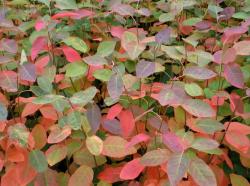
Perfumed clusters of spectacular white flowers, succulent purplish black berries, dazzling orange-red fall color and excellent disease resistance assure ‘Autumn Brilliance’s ticket into your landscape. A small, multitrunked shrubby tree, this Serviceberry is the prized hybrid between two deciduous North American species, Amelanchier arborea and Amelanchier laevis, which Illinois’ Bill Wandell selected in 1986. Handsome, fine-toothed, oval-lanceolate leaves, bronze-tinged when young, line its upright, closely arranged branches. Delectable to both people and birds, the small fruit can be added to jams as well as pies, tasting a bit like blueberries with subtle almond notes. It favors moderate moisture, abides most well-drained sites and makes a compelling understory tree for shrub borders, woodland peripheries plus informal screening or hedging. Large Band.
Blooms April
Size: 15' 0" – 25' 0" high x 15' 0" – 20' 0" wide.
Hardy to zone 4.
Ampelopsis
Porcelain Berry
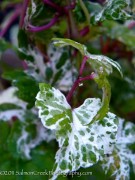
If you want to cover a wall or a fence quickly and dramatically, this is the vine for you. A Japanese denizen, this comely, self-clinging, deciduous climber features young rose-blushed shoots plus small, tight set, deep-lobed leaves patterned with artful pink and white splashes. Light yellow foliage and porcelain-colored berries, darkening to steel-blue, signal autumn’s arrival. Up to 15´ & spreading. Large Band.
Size: 12' 0" – 15' 0" high x 0" & spreading wide.
Hardy to zone 5.
Argyrocytisus battandieri (T-0275)
OUT OF PRODUCTION AT THIS TIME
Email me when this plant is available
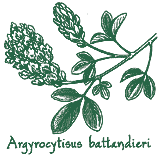
Hailing from North Africa’s Atlas Mountains and sadly rare in cultivation, this RHS award winning, vigorous small tree boasts an extraordinary appearance that understates its surprising hardiness. Large, erect cone-shaped clusters with dense pineapple-scented lemon-yellow flowers festoon the velvety gray-green trifoliate leaves. Evergreen in milder climates, Pineapple Broom’s upright yet relaxed looking bushy habit injects a sumptuous dose of summer cheer to a warm wall, seating area or the backside of a mixed planting. It relishes regular pruning and good drainage, endures deer, poor soil, heat and dry conditions, and thankfully will not reseed. Grows moderately to 10–20' x 8–10'. Medium Band.
Blooms June–mid-August.
Size: 10' 0" – 20' 0" high x 8' 0" – 10' 0" wide.
Hardy to zone 7.
Aristolochia
Dutchman’s Pipe Vine
Dutchman’s Pipe’s glossy tropical-looking mien brings cool, deep shade to your corner of the world, as well as the wild woodlands and streams of the eastern U.S. The delightful, densely cloaked screen generated by this deciduous climber’s flush of large heart-shaped foliage will also dampen street noise and rapidly shield you from the neighbors. With exceptional vigor, old- fashioned appeal, plus a pest and pollution-proof mettle, overlapping dark green leaves shyly reveal intriguing, 2 in. long mahogany and cream-colored tubular blooms, which flare into 3 lobes and evoke a Dutchman’s pipe. A favored food source for the Pipevine Swallowtail butterfly, A. durior appreciates hefty support, adequate space, a late winter cutback and rich, well-drained moist soil, while effortlessly clambering over sun porches, verandas, pillars, posts or fences.
Blooms May–June
Size: 15' 0" – 30' 0" high x 0" & spreading wide.
Hardy to zone 4.
Betula
Birch
Betula pendula ‘Trost's Dwarf’ (T-0278)
OUT OF PRODUCTION AT THIS TIME
Email me when this plant is available
Delicately draped and uber fine, the deeply cut light green deciduous leaves, at first glimpse, may fool you into thinking this exceptional tree is a Lace Leaf Japanese Maple, but step closer and you'll see it's a small growing Birch. 'Trost's Dwarf ' slowly matures into an upright, somewhat rounded compact specimen that celebrates exceptional downy foliage and black etched luminous white bark. Highly coveted by bonsai enthusiasts, it's airy asymmetrical elegance can grace a container, the rockery, a pathway or any other up-front spot with evenly moist well-drained soil. Medium Band.
Size: 3' 0" – 4' 0" high x 3' 0" – 4' 0" wide.
Zone 3/4.
Carpinus
Hornbeam
Scattered across temperate areas of the northern hemisphere, with most species populating east Asia, this fairly small deciduous genus is noteworthy for its hard timber, simple, neatly pleated leaves, hop-like fruiting clusters and understated elegance. Hornbeam’s urbane rich green foliage embellishes an undemanding long-lived habit that appreciates moderate moisture, but tolerates occasional dry conditions once established plus clay and alkaline soil.
Each $26.75
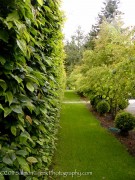
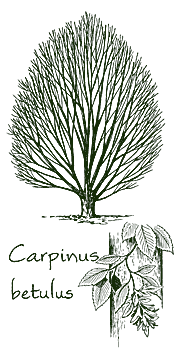
Renown for the grand forest-green hedges it fashions, European Hornbeam premiers glistening tight-knit pleated leaves, and when left unclipped develops a dense pyramidal to rounded silhouette. The toothed oval-shaped foliage takes on splendid buttery yellow fall color against smooth gray bark inscribed with muscular vertically aligned undulations. Enduring wind, heavy pruning and clay soil, cold-hardy Carpinus betulus can be showcased as a hedge, windbreak, single specimen, or planted in an allée, pleached or not. 10´ in 10 years. Large Band.
Blooms March
Size: 40' 0" – 60' 0" high x 20' 0" – 30' 0" wide.
Hardy to zone 5.
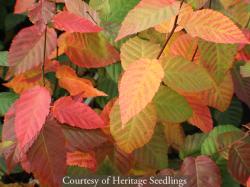
While its common name alludes to the notable smooth bark that’s layered with sinewy undulations upon maturity, the cultivar name announces the blazing red and tangerine fall finale it delivers. This small-statured decidious eastern American native fashions a dense, broadly globe-shaped canopy defined by nutlets amid handsome, prominently veined dark green leaves. Meticulously selected by Wisconsin’s Musclewood enthusiast Michael Yanny, Wisconsin Red™ ‘MY Select Strain’s undemanding habit savors sun or bright dappled light plus adequately moist well-drained haunts, endure clay and walnut soil and lends untold beauty to any garden, especially small residential spaces and woodland plantings.
Size: 15' 0" – 20' 0" high x 10' 0" – 15' 0" wide.
Hardy to zone 3.
Each $26.75
Native to Japan, Korea and China, this slow-growing, small rounded tree draws attention throughout the seasons. Lovely, large heart-shaped dark green leaves with doubly serrated margins and prominent veins lend a graceful quality amid densely-set branches. Big fruiting catkins and sizable cigar-style seed pods provide additional intrigue, while chunky winter buds and unique scaly, fissured coal-gray bark etch the cold weather landscape. Once utilized in crafting agricultural tools and furniture, Heartleaf Hornbeam’s easy-care habit can be planted as a sentinel, deciduous screen or small specimen in space-thrifty gardens and woodland settings where dappled shade plus organic-rich soil ensure its longevity. Large Band.
Size: 20' 0" – 30' 0" high x 12' 0" – 15' 0" wide.
Hardy to zone 5.
Each $26.75
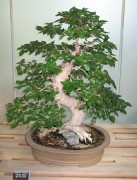
Cherished among bonsai devotees, this graceful multi-stemmed Korean native deserves a prominent place in more landscapes as a small-scale ornamental specimen. Pendulous branches taper into short shrubby, deep brown twigs that are infused with wine hues. Sporting a lustrous spring and summer sheen, the serrated tiny green deciduous leaves orchestrate a fantastic fall finale of flaming red, yellow and orange colors. Appreciative of some protection from hot afternoon sun, especially in dry locations, C. coreana’s refined slow-growing visage can flourish near a bench, a terrace or even in a large container, while its strong growing roots can survive occasional drought. Grows slowly.
Blooms March
Size: 15' 0" – 20' 0" high x 12' 0" – 15' 0" wide.
Hardy to zone 5.
OUT OF PRODUCTION AT THIS TIME
Email me when this plant is available
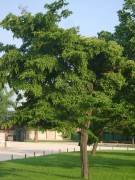
This stellar medium-sized Hornbeam promises to delight all year round. Hallmarking spring and summer, a winsome bevy of small, oval-shaped dark green serrated foliage sport prominent veins, soft yellow-green undersides and slender pointed tips. Long, pendent, bright green and red-tinged fruiting keys accompanied by cozy yellow and red foliage make attractive autumn features, while winter showcases pendulous branches and smooth pale patterned bark.
A rarely offered Japanese native introduced in 1914, the versatile Carpinus laxiflora can be grown as a landscape specimen or serves as an ideal bonsai candidate. 10' in 10 years. Large Band.
Blooms March.
Size: 30' 0" high x 20' 0" – 25' 0" wide.
Hardy to zone 6.
Cercidiphyllum
Katsura Tree
When Japanese philosopher Toshitsuna said that trees “bring the magnificence of heaven to the human realm,” he must have been contemplating a Katsura Tree. The graceful foliage is rounded, almost heart-shaped, announcing spring in purple and bronze, then maturing to a sprightly medium green. In fall, it keeps us guessing with its variable autumn colors: pale or brilliant, yellow or orange, red, pink, or mauve, while the leaves mysteriously exude the distinct scent of fresh strawberries. Give it rich, slightly acid soil and adequate moisture.
Cercidiphyllum japonicum (T-0005)
Each $26.75
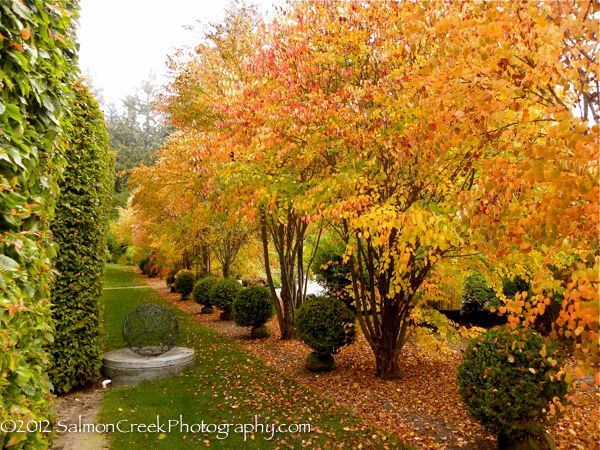
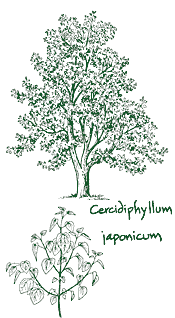
Perhaps Japan’s largest shade tree, normally multi- trunked Katsura manifests a gracious symmetry; trained to a single trunk it provides a narrower, almost columnar shape. Its dappled shade is a cordial host for Corylopsis. Grows moderately to rapidly.
Large Band.
Blooms March–April.
Size: 60' 0" high x 30' 0" wide.
Hardy to zone 5.
Chionanthus
Fringe Tree
Each $25.50
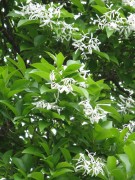
Named for its clustered, snow-white fleecy flowers, the broadly spreading Chinese Fringe Tree casts light shade with rounded leathery leaves. This deciduous Olive family member is a captivating, four season specimen displaying blue, egg-shaped summer fruit, warm yellow autumn foliage and peeling gray-brown bark in winter. Well sized for a lawn or small yard, it’s easily cultivated in moist, loamy soil. Grows slowly. Large Band.
Blooms June.
Size: 20' 0" high x 15' 0" wide.
Hardy to zone 5.
Chionanthus virginicus (T-0034)
Each $25.50
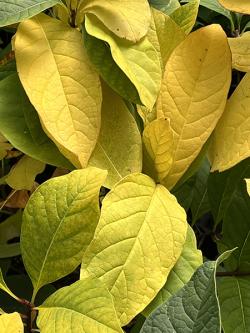
With ample, strap-shaped white blossoms held in fragrant, long fleecy panicles followed by egg-shaped blue fruit, the American Fringe Tree is one of the most beautiful of all North American trees. Found throughout the southeastern United States, this easily maintained variable native brings elegant allure to any garden setting, especially near water, where its openly-branching limbs and glossy green leaves can be reflected in the afternoon light. Grown as a small tree or multistemmed large shrub, Chionanthus is ideal for a lawn or intimate patio area, thriving in moist, well-drained acidic locations, though tolerant of other soil conditions. Grows slowly Large band.
Blooms June–mid-July
Size: 15' 0" high x 15' 0" – 20' 0" wide.
Hardy to zone 4.
x Chitalpa tashkentensis ‘Pink Dawn’ (T-0272)
OUT OF PRODUCTION AT THIS TIME
Email me when this plant is available
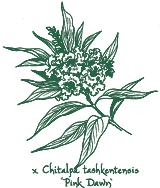
Russian bred and spawned by two American genera, Chilopsis and Catalpa, this stalwart, small deciduous tree debuts copious, upright exotic-looking floral clusters, each housing 15 to 40 light pink orchid-like blossoms. Ruffled margins and purple-lined yellowish throats embellish long blooming, one inch trumpet-shaped flowers to the delight of hummingbirds everywhere. With tapered tips and bases, soft shaggy hairs on the flipsides and a glabrous finish, narrow lengthy green leaves clothe fast growing branches, which are close-set near the ground, then extend outward, casting a wide airy silhouette.
Undemanding, water-thrifty and heat abiding, ‘Pink Dawn’ is equally at ease in modern planting schemes, cottage gardens or Mediterranean landscapes. Grows rapidly. Large Band.
Blooms June–September.
Size: 15' 0" – 25' 0" high x 15' 0" – 25' 0" wide.
Hardy to zone 6.
Cladrastis
Yellowood
Each $27.75
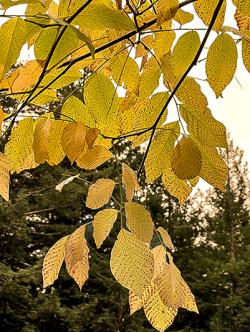
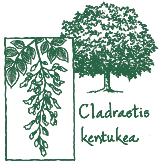
Uncommon in cultivation and considered by many to be the foremost American flowering tree, this southeastern U.S. denizen fashions a graceful broad rounded crown of delicate low-sweeping limbs that create dense shade. The dramatic framework becomes a dignified focal point with smooth pewter-colored bark and prominent flat brown seed pods on sinewy luminous branches. Delightfully fragrant, pendulous, long creamy-white Wisteria-like panicles luxuriate against pinnately compound, rich green foliage defined by 7 to 9 deciduous leaflets, donning silky gray hairs when young and bright butter-yellow hues in autumn. Pest free and drought tolerant, practically indestructible Yellow Wood detests wet feet, favors well-drained loam, yields a yellow dye and supports beneficial nitrogen-fixing bacteria. Grows moderately Large Band.
Blooms May–June
Size: 30' 0" – 45' 0" high x 40' 0" – 45' 0" wide.
Hardy to zone 4.
Clematis
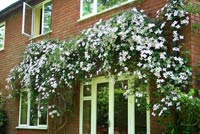
Simple and beautiful, Clematis includes over 300 named cultivars and even more wild species than the rose. Our selections offer stylish blossoms, attractive carefree foliage, and ornamental seed heads, in exchange for a minimum of attention. Use them to cover just about every stump and dead tree, as well as on trellises, arbors, pergolas, walls and tall shrubs. They prefer to be planted slightly deep in cool well-drained soil with mulch or a ground cover to shade their feet; provide a support and let them climb. Each vine is 18 inches to 2 feet tall. Medium Band.
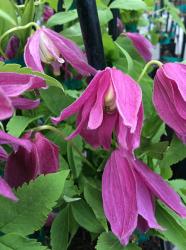
Englishwoman Kathleen Goodman selected this hardy AGM winner as a welcome, easily cultivated improvement over its parent Clematis alpina ‘Ruby’. Abundant nodding blooms garnish thin twining stems and attractive deciduous leaflets, which shape a reliable small-statured habit. With charm to spare, the deep rosy pink bell-shaped flowers showcase a prominent outer layer of long central, petal-like sterile white stamens, followed by playful swirls of eye-catching fuzzy seed heads. Ideal for tight spaces plus intimate garden settings, a north-facing wall or patio container, ‘Constance’ delivers moderate growth and a floriferous early spring gala in well-draining sunny or brightly shaded sites.
Blooms April–May
Size: 6' 0" – 8' 0" high x 0" & spreading wide.
Hardy to zone 4.
Clematis alpina ‘Jacqueline du Pré’ (T-0241)
OUT OF PRODUCTION AT THIS TIME
Email me when this plant is available
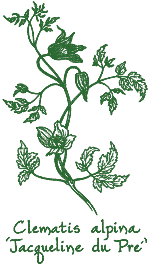
Honored with the same name as the musical luminary Jacqueline du Pré, this Clematis harmoniously orchestrates bright green deciduous leaves arranged in threes, maroon-tinged stems and large, freely borne rosy mauve flowers. Suspended from long stalks, pointed dusky mulberry-hued buds reveal light-centered, semipendent blooms composed of four separate, out curving tepals with pale-blushed margins and darker orchid shades on the exterior.
A shimmering overture announcing spring’s arrival, the dainty floral display garnishes a vigorous, cold hardy vine, acquiescing to both cool, shady northern spots and sunny, more exposed locations.
Blooms April – May.
Size: 8' 0" – 10' 0" high x 0" & spreading wide.
Hardy to zone 3.
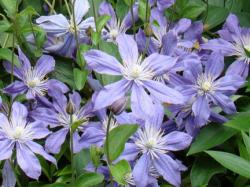
Celebrated as the most popular nonclimbing Clematis and the longest flowering of all Clematis, this 2002 AGM champion promotes plentiful, rounded bright blue-mauve flowers from spring through fall upon a winsome, semiherbaceous shrubby habit. The incessant, 3 in. wide blooms initially glow with a reddish cast, then fade to soft blue, each defined by 4 to 8 classy pear-shaped tepals surrounding pronounced creamy yellow stamens. An exceptional integrifolia descendant well-suited for any garden, ‘Arabella’ can tumble down walls, weave through medium-sized shrubs in a mixed border or forge a compact flowering ground cover.
Blooms June–early-October
Size: 3' 0" – 6' 0" high x 0" & spreading wide.
Hardy to zone 4.
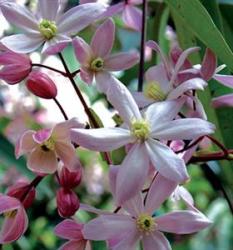
Lolling upon vigorous, yet slightly tender, polished foliage, vanilla-scented, eye-catching clusters of white saucer-shaped 2 to 2 ½ in. flowers are defined by yellow stamens and 4 to 6 well-spaced broad tepals with pink flip sides. Sprightly rose-colored buds and bronze-tinged stems further enhance the long, boat-shaped dark green leaves, which sport conspicuous ribbing, pointed tips and rich coppery hues when young. A 2002 Garden Merit Award recipient, this stylish evergreen climber affords an enticing floriferous display each spring and a handsome year-round presence when situated in a sheltered, well-drained sunny abode, such as a south-facing garden or house wall.
Blooms March–April
Size: 15' 0" – 25' 0" high x 0" & spreading wide.
Hardy to zone 7.
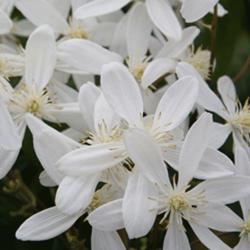
A 1900 introduction by famed plant hunter E. H. Wilson, this energetic award-winner is supposedly one of the most desired evergreen Clematis in cultivation. Large half-hardy deep green leaves—thick, waxy, pointed and copper-infused when young—sculpt a tasteful verdurous screen. Beguiling bees, butterflies, hummingbirds and plant enthusiasts alike, dense axillary clusters of urbane, pure white single flowers, each with 4 to 6 starry tepals, waft a delectable vanilla fragrance. Bright, fast draining niches, protection from cold winter winds, a trim immediately after blooming plus well-rotted compost applied as an early spring mulch ensure a mighty fine specimen.
Blooms March–April
Size: 15' 0" – 25' 0" high x 0" & spreading wide.
Hardy to zone 7.
A late flowering jackmanii descendant, this treasured 1874 introduction was raised by John Standish and named for Ascot, the English town where it originated. Well-formed, clear medium blue blooms include greenish chocolate-colored anthers plus 4 to 6 tepals that initially unfold with a glamorous, metallic deeper blue-mauve luster. Affording late season color, the large bountiful flowers populate most of the stem and stage a lovely presentation in a patio pot. Hearty, deciduous and reliable, ‘Ascotiensis’ can complement red or yellow roses, scale small trees and shrubs or grace a trellis.
Blooms July–September
Size: 8' 0" – 12' 0" high x 0" & spreading wide.
Hardy to zone 4.
Clematis ‘Blue Angel’ (T-0314)
Each $22.75
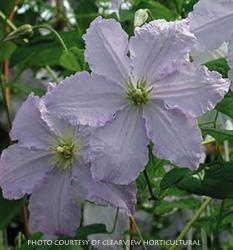
A heavenly combination of ethereal beauty and brawn, this lively midsized AGM recipient spirits a summertime galaxy of 3 to 4 in. wide, pale sky-blue flowers. The floral profusion premiers silky tepals with subtle lilac tinges, deep textural grooves, lighter central bars plus ruffled edges, all swirling around sunny-yellow stamens. Introduced by a Polish monk, Brother Stefan Franczak in 1990, ‘Blue Angel’s spiffy deciduous leafage and long-lasting pastel-hued blooms can sojourn beside a climbing rose or a late spring-blooming shrub such as Philadelphus ‘Belle Etoile’.
Blooms June–September
Size: 8' 0" – 12' 0" high x 0" & spreading wide.
Hardy to zone 4.
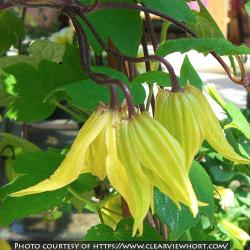
Hats off to the University of British Columbia for selecting this sturdy long-blooming gem from a group of South Korean seedlings. Lustrous wine-colored stems and trim trifoliate deciduous foliage host masses of pastel yellow bells described by thick prominently ridged tepals, burgundy-flushed bases and slender pointed tips, which turn outward. Arising mostly from the previous season’s wood, its nodding fairy-like flowers usher in summer, while airy silver-laced fluffy seed heads extend the enchantment.
Blooms May–June
Size: 6-1/2' – 10' 0" high x 0" & spreading wide.
Hardy to zone 6.
Clematis chrysocoma var. sericea (T-0265)
Each $22.75
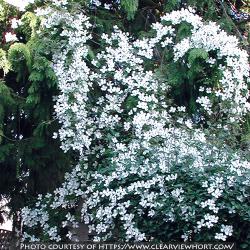
Also known as Clematis spooneri.
An avalanche of white blossoms smothers the deep green rounded foliage, like a heavy spring snowfall in the mountains. Amid 3-lobed deciduous leaflets that are downy on both sides and purple-tinged when young, broad, widely spaced tepals embellish each illuminated flower. This splendid climber bears some semblance to Clematis montana, though its vigorous form is more refined and somewhat less rambunctious, rendering it more suited to a terrace or smaller garden.
Blooms April – early June.
Size: 15' 0" – 20' 0" high x 0" & spreading wide.
Hardy to zone 6.
Each $22.75
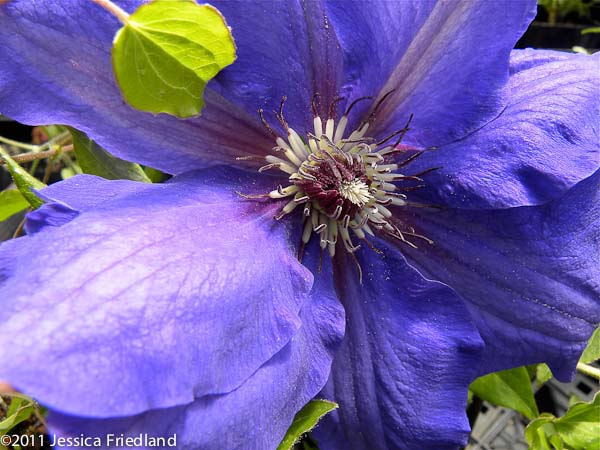
(Vancouver ™)
So smitten with his new introduction, Fred Wein Sr. of Clearview Horticultural Nursery, a leading North American Clematis grower, named it after his darling granddaughter. Overlapping vibrant purple-blue tepals with carmine-tinged central bars and rich red-tipped stamens distinguish ‘Danielle’s large shapely blooms.
Superb as a cut flower and as a container focal point, due to its compact stature, this celebrated Clematis’ richly hued blossoms will festoon your garden in late spring and again in early autumn.
Blooms June & September
Size: 6' 0" – 8' 0" high x 0" & spreading wide.
Hardy to zone 4.
Clematis ‘Doctor Ruppel’ (T-0262)
Each $22.75
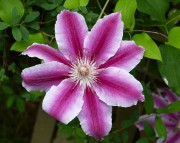
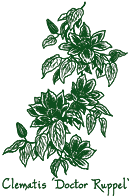
The dexterous hands of an Argentine doctor raised this fabulous free flowering Clematis. Boasting wavy edges and a sensuous satiny luster, each large single blossom is composed of 6 to 8 overlapping rose pink tepals, which encompass candent yellow-brown anthers. Dark fuchsia-colored central brush strokes and tapered points define the tepals. A medium-sized, moderately vigorous stature renders it well-suited for container culture or a garden arch.
Coveted by floral arrangers and hummingbirds alike, ‘Doctor Ruppel’ charms gardeners with repeat bloom periods, curly tailed spherical seed heads and a mettle tough enough to endure strong sunlight.
Blooms May – June & September.
Size: 8' 0" – 10' 0" high x 0" & spreading wide.
Hardy to zone 4.
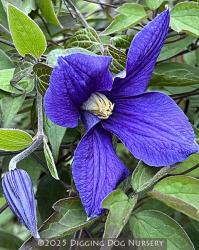
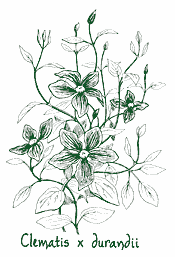
Let ‘Durandii’ twine its way through the branches of your favorite shrub. This semi-herbaceous Clematis is coveted by floral arrangers and gardeners alike for its choice 3-½ to 4 in. flowers and sturdy, nonclinging stems. With centers of creamy white stamens and deeply ribbed tepals, these richly colored indigo-blue flowers will bring an exquisite splash of color to your garden or an arrangement.
Blooms June–September.
Size: 3-1/2' – 5' 10" high x 0" & spreading wide.
Hardy to zone 5.
Clematis ‘Elsa Späth’ (T-0295)
Each $22.75
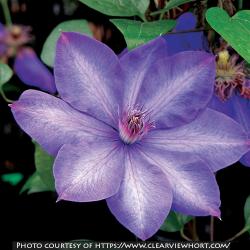
Bred by Berlin-born Ludwig Späth in 1891, ‘Elsa Späth’ enjoys a longstanding popularity thanks to her 6 to 8 in. wide blooms, which reliably festoon both new and old growth for months on end. Conjuring a marvelous deep coloration and looking delectable in cut arrangements, 6 to 8 broad, overlapping rich blue-violet tepals with short points plus dark red anthers define the opulent rounded blossoms. This easy-care highly favored AGM recipient makes a superb compact container specimen or strong growing deciduous companion for shrubs and climbing roses.
Blooms June & September
Size: 8' 0" – 10' 0" high x 0" & spreading wide.
Hardy to zone 4.
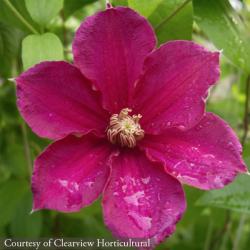
Bestowed a prestigious AGM in 1993, ‘Ernest Markham’s single, 4 to 6 in. wide, rounded blossoms create a long-lasting summertime riot that delights bees, butterflies, hummingbirds and plant connoisseurs alike. The vivacious flowers, each composed of six broad overlapping, wavy-edged tepals, are vitalized by fuchsia-red hues with a velvet sheen plus frilly latte-colored anthers. Sporting a he-man persona and blooms galore, this deciduous fellow is a blaze of glory as his compound bright green leaves ramble through Hydrangea ‘Rocklin’ or over an arched threshhold.
Blooms July–September
Size: 8' 0" – 12' 0" high x 0" & spreading wide.
Hardy to zone 4.
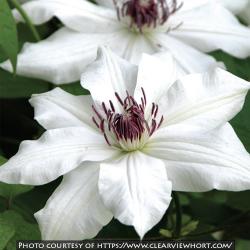
This compact easily managed vine headlines urbane perfectly fashioned star-style white flowers, boasting a 6 to 8 in. diameter, vivid maroon-tipped stamens, a delightful vanilla scent plus a repeat autumn bloom. Recently introduced by Canadian horticulturist Rob Wein, ‘Fragrant Star’ is the celebrated prodigy of a ‘Capitaine Thuilleaux’ and ‘Blue Ravine’ cross. Tinged green when grown in the shade and exceptional when paired with roses, the huge snowy colored flowers enhance a smaller statured deciduous foundation that’s ideal for containers, a trellis or a somewhat openly branched shrub such as a Viburnum.
Blooms May, June & September
Size: 6' 0" – 8' 0" high x 0" & spreading wide.
Hardy to zone 4.
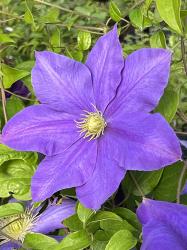
“Girl under Wisteria Bloom” is a marvelous compact deciduous Japanese cultivar, whose namesake aptly alludes to its sizable, long-blooming Wisteria-esque blue-violet flowers. Large plump buds blanketed with short white hairs unfurl flattish and satiny smooth 6 to 7 in. blooms defined by tapered, slightly overlapping tepals, significant saffron-yellow stamens and later, ornamental pouffed golden seed heads. Introduced in 1952, this strong-growing AGM champion can be enthroned on a small obelisk, a threshold or in a patio pot, where the delightful blossoms will cool down the hottest summer afternoon.
Blooms May–June & mid-August–September
Size: 6' 0" – 9' 0" high x 0" & spreading wide.
Zone 4/5.
Clematis ‘General Sikorski’ (T-0248)
Each $22.75
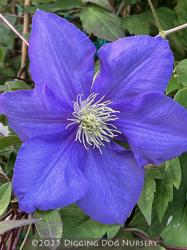
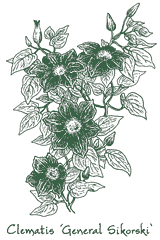
Gold soaked frilly centers heighten the lavish and lengthy showing of large, well rounded mauve-blue flowers, which span some 6 in. across. Gracing lance-shaped deciduous leaflets, long narrow tapered buds herald the marvelous blooms, each described by 6 or 8 broadly overlapping tepals with subtly notched margins and red-tinged bases.
An award winning, compact Polish cultivar whose blossoms and fluffy seed clusters make first-class additions to cut arrangements, the robust ‘General Sikorski’ can be trained up an obelisk or pergola alongside climbing roses, or sited in a container as a colorful summertime specimen.
Blooms June – September.
Size: 6' 0" – 8' 0" high x 0" & spreading wide.
Hardy to zone 4.
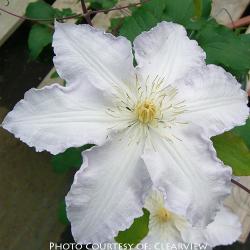
Selected by Clematis connoisseur Jim Fisk in 1975, this deciduous AGM recipient bears a compact medium-sized profile of winsome glistening greenery. Gorgeous, 6 to 8 in. wide star-like white flowers make a chock-full summer-long appearance with 6 to 8 pointed tepals sporting ruched softly hued bluish mauve margins and perky champagne-colored anthers. A beacon for bees, butterflies and floral artists, ‘Gillian Blades’s large luminous blooms plus spherical pewter-laced seed heads can straddle shrubbery, tootle up pillars or enhance patio containers.
Blooms May–June & September
Size: 6' 0" – 8' 0" high x 0" & spreading wide.
Hardy to zone 4.
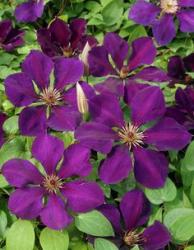
A classy 1877 introduction by the former British nursery Cripps & Sons, ‘Gipsy Queen’ puts on a regal air with plush dark purple flowers borne on strong stems. The gorgeous abundant blooms are composed of burgundy-colored anthers plus 4 to 6 broad blunt-tipped tepals, which are narrow at the base, lending an open aspect amongst deciduous pinnate leaves. This peppy medium-sized AGM winner reigns supreme, either positioned near silver or gold-leafed shrubs or scrambling upon an arbor or column.
Blooms mid-June–September
Size: 10' 0" – 12' 0" high x 0" & spreading wide.
Hardy to zone 4.
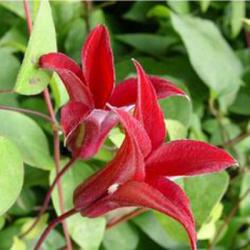
Raised by Frenchman Francisque Morel, this compact, color-rich Clematis claims an intriguing heritage that spans more than a century and includes 2 continents. A probable descendant of Clematis viticella and Jackmanii strains plus Clematis texensis, ‘Gravetye Beauty’ was given to William Robinson in 1914, who named it after his British manor home. Myriad, upward-facing tulip-style flowers, bathed in breathtaking ruby-red shades, feature vivid crimson interiors, subtle pink stripes and reddish brown anthers. The tapered, recurving tepals open widely as they age, resembling signature 4-to 6-pointed stars, while firm herbaceous stems forge a shrubby deciduous base, garbed with attractive dark greenery. Low walls, pint-sized hedges, small trellises and training its stems horizontally promote easy viewing.
Blooms July–September
Size: 8' 0" – 12' 0" high x 0" & spreading wide.
Hardy to zone 4.
Clematis ‘Guernsey Cream’ (T-0316)
Each $22.75
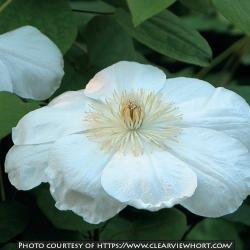
Witness the legions of posh 5 in. wide creamy-white blooms with butter-colored anthers and you’ll see how the namesake came to be. Illuminating a compact deciduous habit, each shapely rounded flower hosts 8 overlapping sepals that are enhanced with pale greenish yellow central bars when they first unfurl. ‘Guernsey Cream’ can nestle alongside early blooming roses or reside in front of medium-sized dark-leafed shrubs to better show off its stunning blossoms plus gleaming silver seed heads.
Blooms May–June & September
Size: 6' 0" – 8' 0" high x 0" & spreading wide.
Hardy to zone 5.
Clematis ‘H. F. Young’ (T-0263)
Each $22.75
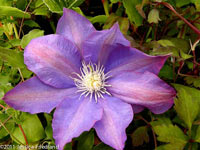
Legions of big, beautiful, blue single flowers highlighted by contrasting cream-colored stamens dress this hardy, RHS award winning Clematis. Between 6 to 8 round-edged tepals extend over one another, emphasizing pointed tips and mauvish blue flipsides, each with a subtle greenish white central zone.
Not as rambunctious as many cultivars, ‘H. F. Young’ sprouts paired, widely spaced deciduous leaves that can drape a pergola, large trellis or an obelisk in a mixed border.
Blooms May – June & September.
Size: 7' 0" – 9' 0" high x 0" & spreading wide.
Hardy to zone 4.
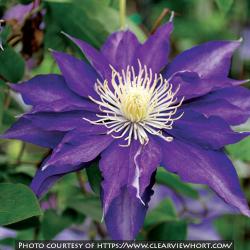
Cultivated by Japanese Esio Kubota and introduced by British Clematis connoisseur Jim Fisk, this free-flowering Clematis is dubbed ‘White Royal Crown’ for its marvelous cluster of large alabaster-colored stamens. Pointed, overlapping saturated violet-blue sepals with veined pale purple central bars describe the cut-flower-perfect 6 in. wide blooms that occasionally present as semidoubles, but always promise a repeat autumn showing. Fanciful spherical seed heads plus a smaller stature give you more reasons to ensconce ‘Haku Ookan’ near your favorite garden bench.
Blooms May–June & September
Size: 6' 0" – 9' 0" high x 0" & spreading wide.
Hardy to zone 4.
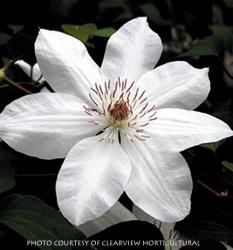
This classy 1855 heirloom climber is one of the oldest white-flowering Clematis and over 160 years later, is still one of the most adored. The generous showing of 6 to 8 in. wide, rounded creamy-white flowers exhibits striking purplish chocolate-colored anthers as well as 6 to 8 smooth overlapping pointy tepals with pale green central bars and a satin-like finish. Tailor-made for arbors, obelisks or nuzzling alongside espaliered shrubs, ‘Henryi’ is an energetic AGM winner whose deep green deciduous stance delivers a second late summer bloom that can be enjoyed in cut arrangements.
Blooms June & August–September
Size: 10' 0" – 12' 0" high x 0" & spreading wide.
Hardy to zone 4.
Clematis heracleifolia var. davidiana (T-0220)
OUT OF PRODUCTION AT THIS TIME
Email me when this plant is available
Prized for its sweetly scented, Hyacinth-like flowers, this pretty semiherbaceous perennial was collected by Pére David near Beijing in 1863. Luminous tight-knit clusters of powdery blue-lavender flowers with curled-back petals are borne at both the leaf axils and stem tips. Medium green and good-sized, the serrated foliage and strong stems form an arresting textural mass that emits a pleasant woodsy aroma when autumn arrives.
Spreading by underground rhizomes, Clematis var. davidiana is certain to spark attention as it rambles around Deutzia setchuenensis var. corymbiflora in a mixed grouping.
Blooms late July–September.
Size: 3' 0" high x 0" & spreading wide.
Hardy to zone 5.
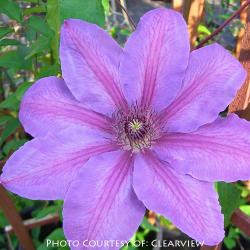
A captivating 1962 introduction, this free-flowering Dutch beauty begets enormous 7 to 9 in. wide, vivid rosy-purple blooms. Adorned with veined darker-hued central bars plus crinkled, slightly notched margins, the 6 to 8 overlapping blunt-tipped tepals gather around saucy red anthers. Granted a well-earned AGM, ‘Horn of Plenty’ grows as a tailored close-knit deciduous vine that’s ideal for scampering up an obelisk, trellis or post, while its long-lasting cup-shaped flowers and shapely seed heads lend glorious accents either outside or in a bouquet.
Blooms May–June & September
Size: 6-1/2' – 10' 0" high x 0" & spreading wide.
Hardy to zone 4.
Each $22.75
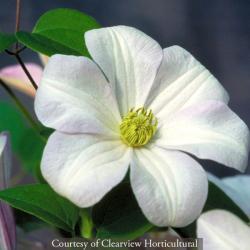
Bred nearly 100 years ago in France, ‘Huldine’ faithfully delivers copious pearly white, cup-shaped blooms all summer long. Amid plump pointed buds, dark stems and handsome, strong growing deciduous greenery, the perfect-for-cutting, 3 to 4 in. luminous flowers are held upright, while uniting 6 translucent nonoverlapping tepals around a cluster of greenish yellow anthers. This sophisticated hardy Clematis features recurving tips and slightly incurved, mauve-blushed margins. It is best grown over a large trellis, arch or pergola—anywhere the lovely undersides, which glow with 3 pinkish mauve central bars per tepal, are easily relished.
Blooms July – October.
Size: 10' 0" – 15' 0" high x 0" & spreading wide.
Hardy to zone 4.
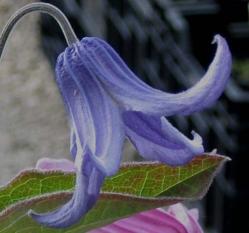
Developed in 1947 by Canada’s impressive hybridizer Dr. Frank Skinner, this select seedling originated from a C. integrifolia and C. viticella cross. A pleasing fan-like symmetry is achieved as sturdy nonclinging stalks, needing only minimal support, produce paired wiry stems that jut out at pronounced angles with 4 in. wide steel-blue bells at their tips. Several hundred gracefully flaring flowers appear nonstop for a stunning nearly 3 month long display, while a moderate trimming produces yet another round of blooms. ‘Blue Boy’s sleek, compact habit can be threaded into a rose, grown alongside C. x durandii or premiered in a pot.
Blooms June–September
Size: 4' 0" – 6' 0" high x 0" & spreading wide.
Hardy to zone 4.
OUT OF PRODUCTION AT THIS TIME
Email me when this plant is available
Named as a tribute to acclaimed Dutch Clematis doyenne Jan Fopma, this wondrous, new scrambler exhibits the best attributes of both its parents, Clematis integrifolia and Clematis fusca, thanks to fellow Dutch plant breeder, Wim Snoeijer. Slender, semiherbaceous stems and natty, pointed, deciduous green leaves give way to a long-lasting chocolate-scented flood of open, thick-walled, rosy purple bells with dainty flared tips, darker purple interiors and light pink margins. A fanciful spectacle for bees, butterflies and all who behold it, small-statured ‘Jan Fopma’ parades delicate, silken seed heads for late season appeal, tumbles over container rims, laces through shrubs or clambers upon obelisks.
Blooms July–September
Size: 5' 0" high x 0" & spreading wide.
Zone 5b.
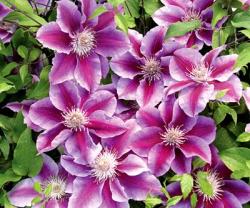
Embroidered by decorative clusters of burgundy-tipped white anthers, giant 5 in. wide blossoms are a florist’s dream and a gardener’s boon. Prolific bicolored blooms manifest ever-changing hues as they mature and fool you into thinking two different Clematis are intertwined. Newly unfurling pink tepals showcase bold stripes in plush ruby red shades that develop orchid-tinted borders plus brilliant fuchsia hues. Eventually they mellow to a pronounced pink, while the background adopts a warm lavender cast. Headlining a unique summer-long floral display, handsome deciduous leafage and a relatively small stature, this phenomenal Clematis is tailor-made for a container or an exalted patio position.
Blooms June – September.
Size: 8' 0" – 10' 0" high x 0" & spreading wide.
Hardy to zone 4.
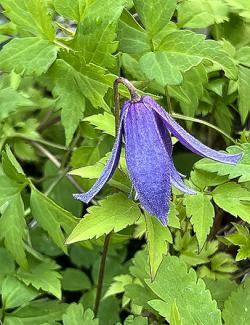
A pollinator’s delight and friend to gardeners short on space, this alluring deciduous climber proffers subtly scented plum-burgundy bells composed of 4 pointed tepals dressed with pronounced ridges, a satin-like finish and pastel green staminoides. The nodding dusky-hued flowers transform into fluffy decorative seed heads amidst handsome dentate green leaflets. Well suited for container culture, hardy ‘Brunette’ can scamper up a medium-sized trellis or obelisk, where it cherishes a warm well-drained niche, but detests wet feet.
Blooms April–June & September
Size: 6' 0" – 9' 0" high x 0" & spreading wide.
Hardy to zone 3.
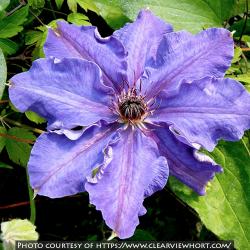
Once you invite this voluptuous show-stopper into your garden, it’s easy to see why ‘Lord Neville’ has remained popular for over 100 years. Adorned with dramatic white filaments and red anthers, the textural deep blue blossoms span 6 to 8 in. across, featuring 6 or 8 large heavily veined, ruffle-edged tepals that overlap at their bases and taper to fine sophisticated points. Followed by small open spherical seed heads amid attractive green deciduous foliage, lavish long-blooming flowers make fantastic additions to arrangements. This moderately vigorous Clematis looks best against a light backdrop, where he can ascend trellises, obelisks and pergolas or be grown next to wall-trained shrubs.
Blooms May, June & September
Size: 8' 0" – 12' 0" high x 0" & spreading wide.
Hardy to zone 4.
Clematis macropetala ‘Blue Bird’ (T-0037)
Each $22.75
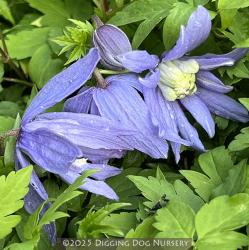
We especially like this lusty deciduous cultivar for its smoky-silver seed heads. But nodding violet-blue flowers with inner petals of cream also combine with young red stems and coarsely toothed medium green leaves to make this species a colorful favorite.
Blooms June–September
Size: 15' 0" high x 0" & spreading wide.
Hardy to zone 4.
Clematis macropetala ‘Blue Lagoon’ (T-0328)
Each $22.75
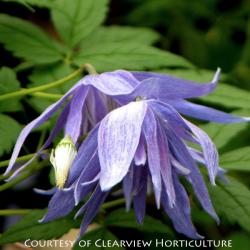
Touted as the darkest of all the blue-flowering macropetala cultivars and perhaps later to open than many of them, this beguiling AGM winner was introduced by George Jackman in 1959. Serrated, deeply lobed green leaves make an attractive deciduous foil for droves of large, 2 ½ in. semidouble nodding blooms with slim, spiky midnight-blue tepals, lucent cream-colored centers and a lovely, open lantern-like aspect. Sprouting silken smoky-hued seed heads that keep our interest piqued, ‘Blue Lagoon’s strong-growing slender habit blooms equally profuse in sun or shade, endures extreme winter conditions and tantalizes both garden visitors and floral designers plus bees and butterflies.
Blooms April–May
Size: 6' 0" – 10' 0" high x 0" & spreading wide.
Hardy to zone 3.
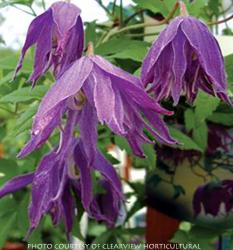
Raised by the namesake, an acclaimed Clematis enthusiast, this wondrous small statured climber originated as a Clematis macropetala ‘Bluebird’ seedling in the early 1980s. One of the first macropetala hybrids to bloom, ‘Jan Lindmark’ fashions spidery-looking double pinkish purple flowers with 4 outer dark-streaked tepals plus an inner skirt defined by long, twisted petal-like staminodes donning paler mulberry hues. The nodding white-centered blossoms beguile bees, butterflies and floral designers amid tasteful deciduous greenery. Ideal for intimate courtyards, terracotta vessels or against a golden-leafed shrub, its compact, impressively cold-tolerant habit cushions a late season display of pouffed pewter-hued seed heads.
Blooms April–May
Size: 7' 0" – 9' 0" high x 0" & spreading wide.
Hardy to zone 5.
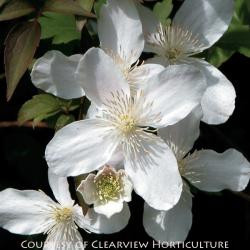
Deemed by many to be one of the best montana species available, this hardy AGM stunner lauds admirable deciduous pep as well as elegant cascades of Anemone-like pure white blossoms. The early-flowering 4-tepaled blooms are garnished with prominent primrose-yellow stamens plus a sweet perfume. Clothed in attractive, serrated and trifoliate dark greenery, the rambunctious sky-bound stems can readily cover old tree stumps, garden sheds and somewhat substantial pergolas, or hide an unsightly fence. Judicious pruning after the flowers fade helps maintain a fresh appearance and a manageable size.
Blooms May–June
Size: 25' 0" – 35' 0" high x 0" & spreading wide.
Zone 5b/6.
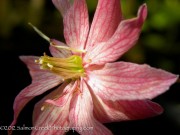
Claiming the British Clematis Society’s 1998 Certificate of Merit Award, this peerless “star” was named after a local parish by the English couple who bred it. Each 2 ½ in. semidouble flower is the color of crushed strawberries and features a distinctive inner ring of tepals, luxuriously staged against bronzy-green deciduous foliage. For a far-reaching display of enticing blooms aplenty, let ‘Broughton Star’s plucky stems weave their way amid the Dove Tree’s heart-shaped leaves.
Blooms May–June
Size: 15' 0" – 20' 0" high x 0" & spreading wide.
Zone 5/6.
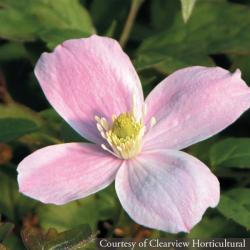
This deliciously vanilla-scented cultivar boasts masses of tenderly pink, 2-¼ in. blooms, each with a satiny sheen, rounded tepals and a spiky yellow center. Young deciduous stems are tinged burgundy, and new purple-tinted trifoliate leaves age to a handsome green bronze as the flowers melt away.
Blooms May – June.
Size: 25' 0" – 30' 0" high x 0" & spreading wide.
Hardy to zone 6.
Clematis montana ‘Pink Perfection’ (T-0128)
Each $22.75
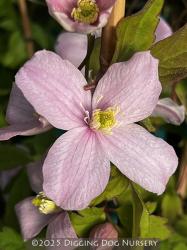
A deliciously vanilla-scented cultivar—very floriferous—whose rounded tepals, once opened, form an almost cup shaped, tenderly pink bloom centered with yellow anthers. Young stems are tinged burgundey, and purple-tinted new leaves age to a handsome green bronze as the flowers melt away.
Blooms May–June
Size: 25' 0" high x 30' 0" & spreading wide.
Hardy to zone 5.
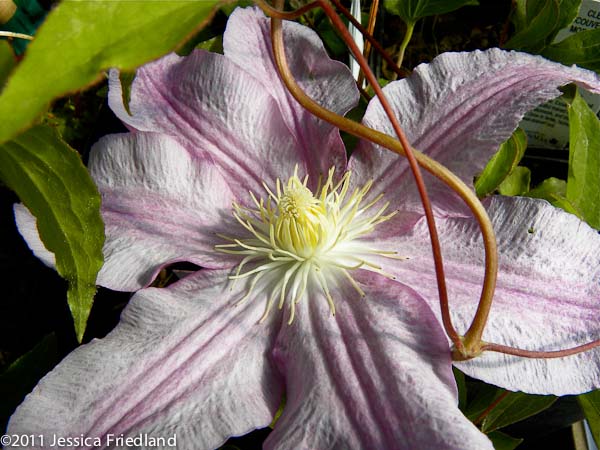
(Vancouver™)
Ample, soft pink and ruffled edged, the 7 to 9 in. flowers of this new Clearview Nursery introduction achieve a decidedly feminine visage. Central hubs defined by white filaments with yellow anthers, slightly darker pink midribs and hot pink edges augment an elegant presentation that spans 3 seasons.
Originating from a cross between ‘Souvenir du Capitaine Thuilleaux’ and ‘Kathleen Wheeler’, ‘Morning Mist’ fashions attractive green deciduous foliage, grows vigorously into a well-branched, small-sized vine, and looks stylish in a glossy black vessel.
Blooms May – June & September.
Size: 6' 0" – 8' 0" high x 0" & spreading wide.
Hardy to zone 4.
Clematis ‘Mrs. Robert Brydon’ (T-0131)
OUT OF PRODUCTION AT THIS TIME
Email me when this plant is available
A lovely North American hybrid between Clematis virginiana and Clematis tubulosa raised by Robert Brydon and named for his missus, this herbaceous nonclinging Clematis sprawls from a vigorous free flowering woody base, creating delicate sprays of milky blue Hyacinth-like blooms at leaf axils plus a good patch of divided deciduous foliage. Prominent cream-colored stamens and 4 widely spaced recurving tepals define the faintly fragrant flowers that later develop fluffy silver seed heads. Grateful for moist free draining soil, 'Mrs. Robert Brydon' can enhance cut arrangements, cover an old tree stump or low wall and forge an unifying textural ground cover.
Size: 6' 0" – 8' 0" high x 0" & spreading wide.
Zone 4/5.
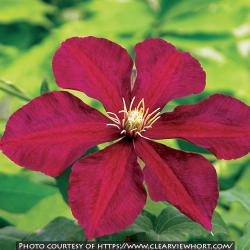
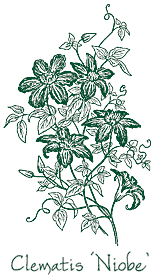
For its hardy, manageable habit and its quantities of large, glamorous long blooming flowers upon tapered green leaves, this acclaimed deciduous Clematis earned the coveted RHS award in 1993 and world-wide notoriety. Single, flat-faced and centered with sprightly yellow stamens, each nearly 6 in. wide bloom hosts 6 to 8 rich as velvet, ruby red tepals, which are broad at the base, narrow toward the tip and age to a fine red-wine color. Bred by Poland’s Wladyslaw Noll, ‘Niobe’s compact form can cozy up to climbing roses or be featured as a regal specimen in a mixed bed or a container.
Blooms June – September.
Size: 6' 0" – 7-3/4' high x 0" & spreading wide.
Hardy to zone 4.
Each $22.75
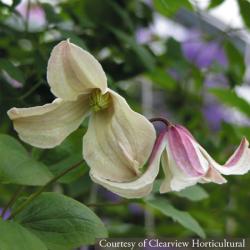
Open, gently nodding porcelain-colored blooms are composed of greenish yellow anthers encompassed by 4 recurving pointed sepals with interior rosy-mauve margins plus delicate pink veining. Lounging upon compact deciduous greenery, the elegant Pagoda-style sepals flaunt a swank deep purplish pink central bar on each flip side and become more curly and twisted as they age. A Clematis viticella and Clematis texensis ‘Etoile Rose’ descendant that originated at Britain’s Treasures Nursery, ‘Pagoda’s tidy midsized habit and award-winning summer-long floral display can be admired in a patio container or on a short earthen column.
Blooms July–September
Size: 6' 0" – 9' 0" high x 0" & spreading wide.
Hardy to zone 4.
Clematis ‘Pamiat Serdtsa’ (T-0243)
Each $22.75
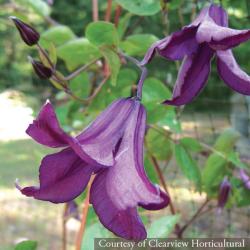
With a name that translates “memory of the heart,” this vine’s floral elegance is hard to forget. Long blooming and satin sheened, the rich colored heliotrope purple blooms show off darker, glossier midribs. Caught in a partially open, spirited flounce that surrounds pale yellow anthers, the 3 in. long tepals are sometimes twisted and irregularly edged. ‘Pamiat Serdtsa’s sturdy herbaceous shoots will climb and saunter but not cling, while slightly nodding blooms pose suspended from subtly crooked stems.
Developed at the Ukraine’s Nikita Botanic Garden, she etches an exquisite juxtaposition of color when meandering up through Spiraea ‘Ogon’ in the mixed border.
Blooms July–September.
Size: 4' 0" – 6' 0" high x 0" & spreading wide.
Hardy to zone 3.
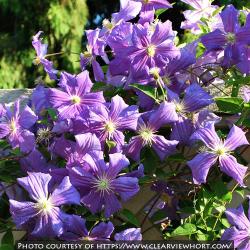
Gracing gardens with its classic sky-blue presence for over 100 years, freely-flowering ‘Perle d’Azur’ presents 4 in. wide seminodding blooms centered by light green stamens and a tinge of pinkish mauve. The nearly translucent tepals have deeply grooved midribs and recurving edges, which make each exquisite flower appear more rounded. This robust deciduous Clematis puts on a lofty show as it meanders through the gold-hued foliage of Physocarpus ‘Dart’s Gold’.
Blooms June–September
Size: 10' 0" – 15' 0" high x 0" & spreading wide.
Hardy to zone 3.
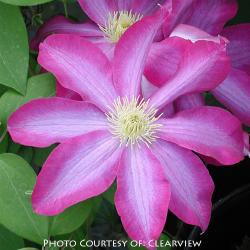
Celebrated for its early profusion of large prismatic flowers, this tight-set medium-sized vine was raised by Kazushige Ozawa in 1971. The bicolored purplish pink blooms present fringe-like bright yellow stamens that clutch 6 to 8 overlapping, vibrantly hued pointed tepals with pink-veined, softer-hued rosy-mauve central bars. Entertaining dapper deciduous greenery, a generous late summer bloom and stylish silver-tinted seed heads, ‘Pink Champagne’s somewhat diminutive carriage can be squeezed into narrow nooks and gardens short on space, or staged upon a small post.
Blooms May–June & September
Size: 6' 0" – 8' 0" high x 0" & spreading wide.
Hardy to zone 4.
This remarkable Clematis vitalba and Clematis jouiniana progeny spawns a robust, weed-suppressing carpet of thick, sprawling, nonvining stems and large, serrated dark trifoliate greenery. Earning an Award of Garden Merit plus high ratings from the Chicago Botanical Garden’s Clematis trials, its hardy herbaceous bearing is garnished with marvelous, Hyacinth-like white crowns of mostly 4-tepaled pale mauve flowers that don ridged margins, rose-stained recurving tips and fringe-like centers. Touted as the best ground cover-style Clematis, easy-care ‘Praecox’ is an appealing deciduous candidate for hiding unsightly features, sauntering over rocks, skirting beneath a tree or blanketing a bed.
Blooms July–mid-October
Size: 2' 0" – 6' 0" high x 0" & spreading wide.
Hardy to zone 4.
Each $22.75
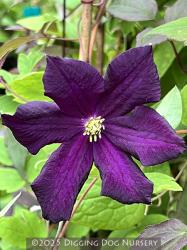
The firm, well-formed 3 to 5 in. wide flowers assume a velvety sheen, which imparts the darkest, most lavish purple-black shades imaginable when it’s overcast, and mysteriously morphs to dark violet when the sun comes out. Introduced in 1983 by Uno Kivistik, this deciduous vine’s dramatic blossoms are composed of 4 to 6 tepals, each with a heavily grooved central band, and pronounced, frilly light yellow stamens, creating a stunning contrast. ‘Romantika’s floral profusion can be showcased in a large container, splashed upon an obelisk or trellis, planted next to roses or situated by silver or golden foliage for heightened appeal.
Blooms mid-June–September
Size: 6' 0" – 9' 0" high x 0" & spreading wide.
Zone 3/4.
Each $22.75
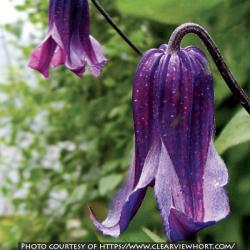
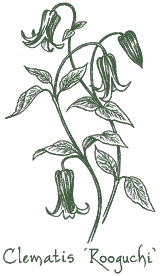
Dangling from the curved ends of lax stems, dark plum-colored droves of dainty ribbed bells, edged in light lavender, present a continual summer fling. The 3 in. long blooms emphasize prominent curled up tepal tips that add fairy tale charm. Hybridized by Kazushige Ozawa, this endearing Clematis grows as an herbaceous perennial, its nonclinging stems can enhance a container, form a ground cover or wind their way through an airy shrub.
Blooms June–mid-October
Size: 6' 0" – 8' 0" high x 0" & spreading wide.
Hardy to zone 3.
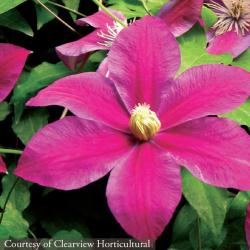
Large freely borne, summer-long blooms boasting extravagant dark reddish magenta hues earned this hardy Clematis an AGM and a hummingbird entourage. Inscribed by spry canary-colored anthers and six to eight subtly textured tepals, each with a pointed tip plus a bold lustrous cerise central bar, the starry single flowers loll amid attractive compound deciduous greenery. ‘Sunset’s compact midsized foundation spangles the ravishing splendor of a setting sun in your garden, whether it’s skedaddling up a smaller trellis or scrambling upon a medium-statured shrub such as Heptacodium miconioides.
Blooms June–September
Size: 6' 0" – 9' 0" high x 0" & spreading wide.
Hardy to zone 4.
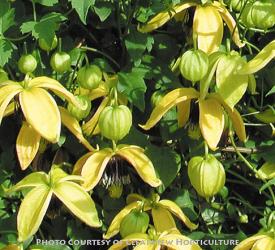
A new variety from Holland, this robust deciduous climber is adorned with exceptional seed heads, which look like loose silky balls of shiny silver thread. The four-tepaled, nodding golden yellow flowers will cascade over stone walls or be carried on mischievous stems to adjacent shrubs. It is especially enchanting entwined among Melianthus major.
Blooms July–September.
Size: 15' 0" high x 0" & spreading wide.
Hardy to zone 5.
Each $22.75
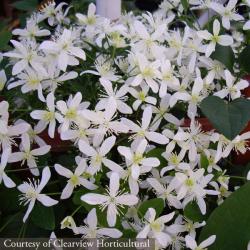
This spectacular New Zealand native is covered with small white flowers borne on long, arching panicles. The pink anthers, silky seed heads, and dark glossy leaves combine with the Hawthorn-like fragrance of the flowers to create a sensuous, alluring effect. We trained our Sweet Autumn Clematis to grow horizontally against a wall, so that the evergreen foliage contrasts with the hanging flower panicles.
Blooms August – October
Size: 25' 0" high x 0" & spreading wide.
Hardy to zone 6.
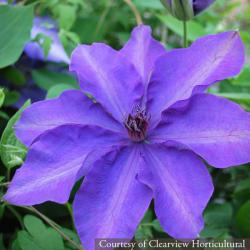
Raised by a Mr. Charles Noble in 1876, this RHS award winner is a widely popular early flowering Clematis. The large plush purple-blue blossoms are somewhat cupped and well-endowed with 6 to 8 wavy margined overlapping tepals. Lounging amongst dark green deciduous foliage that is bronze-toned when young, the 7 in. wide repeat blooming flowers offer additional enticements: pointed tips, silvery undersides, pronounced dark red anthers and open spiky seed heads. Whether scaling a column or pergola, or clambering upon silver or golden foliaged plants for heightened contrast, ‘The President’s color-rich compact habit earns our vote.
Blooms mid-May–September
Size: 8' 0" – 10' 0" high x 0" & spreading wide.
Hardy to zone 4.
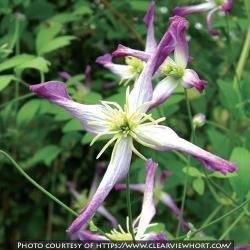
Believed to be a natural deciduous hybrid between Clematis flammula and Clematis viticella, the ruby-margined flush of this floriferous 1860s cross is made more delectable by its rich, marzipanlike fragrance. Arranged in terminal panicles, starry white, four-tepaled, 1-½ in. blooms are drawn together by creamy anthers. Assuring billows of bloom, vigorous ‘Rubromarginata’ imparts a celestial charm amid the golden foliage of Physocarpus ‘Dart’s Gold’ or a dark green Yew.
Blooms July–early October.
Size: 10' 0" – 13' 0" high x 0" & spreading wide.
Hardy to zone 5.
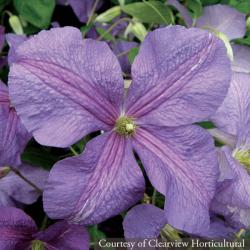
A resplendent English cultivar raised by Cripps & Sons in 1867, this popular vintage Clematis has a lot to offer: well-formed richly hued 5 ½ in. blooms, excellent cold hardiness and vigor aplenty. The deep rosy mauve flowers are composed of 4 to 6 broad overlapping tepals with pointed tips, slightly notched margins plus deeply grooved pinkish purple midribs that eventually lighten to mauve. Sporting bright greenish yellow anthers, �Victoria�s plush bountiful blooms need a light background for best effect, while its handsome visage lends itself to scaling pergolas and arbors, rambling through shrubs or accompanying roses and other Clematis.
Blooms July–September
Size: 9' 0" – 12' 0" high x 0" & spreading wide.
Hardy to zone 4.
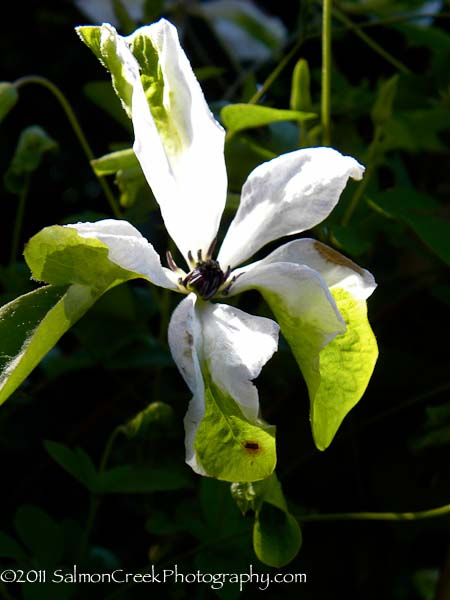
The unusual open blossoms of this vigorous Clematis bob like pale butterflies drifting on the breath of a lazy wind. Luminous against the slightly glaucous foliage, the recurved tips of each 3 in. white flower are brushed with green, while its prominent eye of dark purple anthers is tipped with black. Plant with roses and let them intertwine up and over a pergola, or contrast it with the purple foliage of Sambucus ‘Black Beauty’.
Blooms July – September.
Size: 10' 0" high x 0" & spreading wide.
Hardy to zone 4.
Clematis viticella ‘Emilia Plater’ (T-0245)
Each $22.75
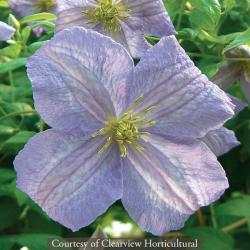
Bred by an 85 year old Polish monk in 1967 and named after a young Polish freedom fighter from the early 1800s, this vigorous cultivar exhibits grace and unwavering tenacity. Her splendid summertime flowers, painted in stunning bluish lavender hues, are considered large for a viticella, measuring 4 to 6 inches across given favorable growing conditions.
Widely spaced tepals surround creamy green anthers and are distinguished by undulating edges, recurving tips, shaded central bars and darker veins. Acquiescent to most garden soils, even drier ones, 'Emilia Plater' can ramble up a pole in the midst of the border backed by Buddleja knappii's silver and green leaves.
Blooms July-September
Size: 10' 0" high x 0" & spreading wide.
Hardy to zone 4.
Clematis viticella ‘Etoile Violette’ (T-0042)
Each $22.75
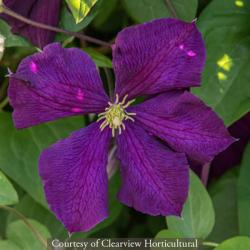
Long-lasting volumes of regal, dark inky purple blooms envelop this energetic, French-bred AGM recipient from midsummer through early fall. A classic care-free garden mainstay since 1885, ‘Etoile Violette’s neat pinnately trifoliate green leaves are nearly obscured by the single, 2 to 3 in. seminodding flowers that feature spritely cream-colored stamens clutching four to six broad well-spaced tepals, each with blunt tips plus a satin gleam. Spotlight the robust deciduous habit on pillars, hightailing up trees, scampering upon shrubs and intermingling with yellow-flowering Rosa ‘Crepuscule’.
Blooms June–September
Size: 9' 0" – 12' 0" high x 0" & spreading wide.
Hardy to zone 4.
Clematis viticella ‘Kermesina’ (T-0222)
Each $22.75
Plush crimson hues imbue the blooms of this robust and free flowering deciduous cultivar raised in the 1880s by the well-known French nursery, Lemoine. Green-tipped upon opening, four rubescent tepals exhibit illuminated white bases and margins that curl under, while their vivid dance encompasses a central hub of black anthers. The luxurious, downward glancing blossoms create an alluring vignette against a pearly colored backdrop.
Blooms June–September.
Size: 10' 0" – 12' 0" high x 0" & spreading wide.
Hardy to zone 4.
Clematis viticella ‘Polish Spirit’ (T-0136)
Each $22.75
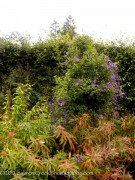
An outstanding cultivar introduced by a Polish priest, this sumptuously colored Clematis has long, slender buds and a satiny, wavy-edged bloom of saturated purple. Each tepal is marked with a subtle deep fuchsia central stripe and accented by wine-colored anthers and chartreuse styles. Dense, deciduous foliage holds its vibrant good looks all the way to the ground. Lovely from below, let it scramble up and over an archway.
Blooms July – September.
Size: 10' 0" – 13' 0" high x 0" & spreading wide.
Hardy to zone 4.
Clematis viticella ‘Royal Velours’ (T-0223)
Each $22.75
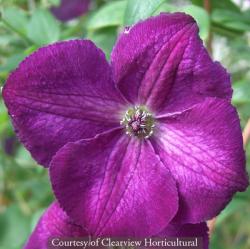
Distinguished by a velvety texture and satin-like sheen, ‘Royal Velours’s intense deep wine-purple flowers are considered the ‘darkest of the dark’. Legions of opulent semi-nodding flowers feature 4 to 6 overlapping tepals embellished with deeply grooved lighter midribs and greenish black anthers. A stunning 1914 French selection, this hardy deciduous AGM winner can be superimposed against golden foliage or a silvery backdrop like Teucrium fruticans (Select Form), guaranteeing a magnificent summer time spectacle.
Blooms June–September
Size: 9' 0" – 12' 0" high x 0" & spreading wide.
Zone 3/4.
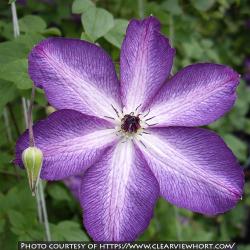
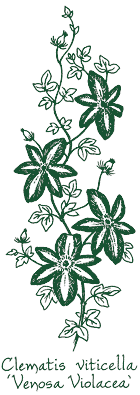
Introduced by the famed French nursery, Lemoine in 1884 this magnificent two-toned AGM winner, though listed as a viticella, begets the largest most distinctive flowers of the species. Overlapping slightly at each base, 6 boat-shaped tepals encompass black-tipped stamens and sport white central swathes with feathery pinkish purple veins that intensify to forge a solid violet border plus a vivid star-like pattern. Long lasting as a cut flower, the gorgeous 4 to 6 in. wide blooms blanket attractive fresh green foliage for most of the summer. Robust, yet moderately sized, ‘Venosa Violacea’ can grow alongside climbing roses or over golden heathers, up lampposts and trellises, through large shrubs or against silver-laced foliage.
Blooms June–September
Size: 8' 0" – 10' 0" high x 0" & spreading wide.
Hardy to zone 4.
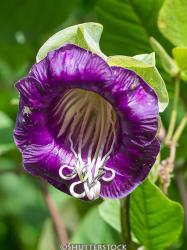
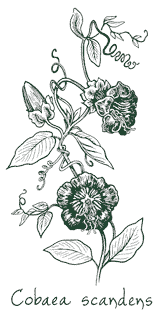
Conjuring an Alice in Wonderland adventure, this impressive fast growing climber sprouts deep green pinnate leaflets, tendrils galore and an eye-catching bonanza of inky purple-colored Campanula-like bells with a musky scent, shapely stamens and ruffled green bracts. The tender hummingbirdfriendly Cup and Saucer Vine hails from Mexico and tropical South America, so it naturally works best as a quick-cover annual or container specimen in cold climates and a stand-alone evergreen in warmer ones. Wondrous even to Charles Darwin, who included it in his 1875 book about climbing plants, Cobaea scandens' floriferous display relishes moist free draining soil and still entrances garden visitors today. Large band.
Blooms June–September.
Size: 10' 0" – 20' 0" high x 0" & spreading wide.
Hardy to zone 9.
OUT OF PRODUCTION AT THIS TIME
Email me when this plant is available
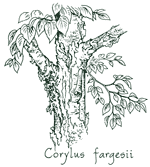
Acclaimed for a strongly upright medium-sized habit and dramatic exfoliating River Birch-like bark, fast growing Farges Filbert was first mentioned in the late 1800s, but not introduced in the U.S. until after a 1996 Chinese, plant collecting expedition. Large, toothed oval green leaves show off a neat appearance –pink-blushed when young and yellow for a fall finale–amid tan and copper bark that sheds dramatic paper-thin creamy salmon-colored sheets. An underutilized deciduous specimen tree boasting year-round appeal and tremendous ornamental value, Corylus fargesii tackles difficult urban sites, grows in average garden soil, easily adapts to an array of climatic zones and seems unfazed by pests. Grows quickly
Large Band
Size: 20' 0" – 30' 0" high x 18' 0" wide.
Hardy to zone 6.
Dalechampia dioscoreifolia (T-0281)
OUT OF PRODUCTION AT THIS TIME
Email me when this plant is available
An extraordinary evergreen Euphorbia relative, this quick-to-establish Costa Rican vine generates alternate 5 in. long rough-finished heart-like leaves, which render a pleasant, yet rather unassuming light green backdrop. Twin 2 to 3 in. long broad serrated bracts with iridescent fuchsia purple shades and pronounced veins evoke an enormous butterfly, while encompassing small button-shaped lime-yellow flowers. Well-suited for container culture, Purple Wings asserts drama queen chic as magnificent Poinsettia-style blooms unfurl nearly year round; cool sun, moderate moisture, well-drained soil and protection from temperatures below 25° ensure its success. Large Band.
Blooms June – October.
Size: 15' 0" – 20' 0" high x 3' 0" wide.
Hardy to zone 9.
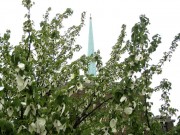
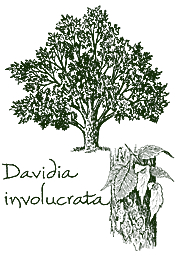
First glimpsed by the French missionary Armand David in 1869, this Chinese native, with its broad pyramidal habit, is perhaps the best known of all hardy exotic trees. The divine white bracts have been likened to doves, handkerchiefs and huge butterflies hovering among the trees. Boosting the Dove Tree’s esteemed reputation are the broad heart-shaped leaves, scaly bark, and ornamental green fruit, which turns rust, resembling giant gooseberries, and persists until winter. This exceptional specimen casts light shade, prefers loam, and needs protection from wind, drought and overly moist soil. Grows slowly Large Band.
Blooms May
Size: 20' 0" – 25' 0" high x 15' 0" wide.
Hardy to zone 6.
OUT OF PRODUCTION AT THIS TIME
Email me when this plant is available
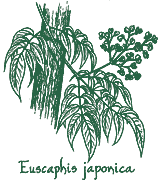
Mysteriously hard to find and a tree connoisseur’s treasure, the exquisite Korean Sweetheart Tree is named for its splendid heart-shaped vivid cherry red seed capsules, which appear in fall and later unveil round shiny black seeds. Unparalleled deciduous foliage—thick, lustrous, emerald green and lanceolate—garbs the slow growing horizontal branches that manifest stunning purplish mocha-colored bark with milky white stripes.
Introduced by the late JC Raulston after a 1985 expedition to the Korean Peninsula, this lovely small tree celebrates year-round intrigue, remaining undeterred by drought, pests or disease. Euscaphis japonica’s practical attributes abound: young buds are a Korean delicacy, while the fruit is cherished by birds and wildlife, the hewn wood crafts furniture, and various plant extracts yield soap, tannins and medicinal components. Large Band.
Blooms May.
Size: 20' 0" high x 10' 0" – 15' 0" wide.
Hardy to zone 6.
Each $23.00
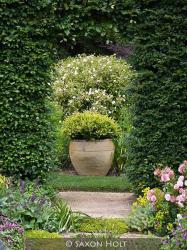
Widespread throughout central and southern Europe and east to the Caucasus region, this gracious, long-cultivated tree has been dubbed "the Queen of British trees" and continues to be among the most beloved, classic hedge choices available. European Beech’s large, upright-rounded and spreading crown fashions a dense dicidious canopy of low slung branches plus posh, wavy-edged dark green leaves that don an ovate to elliptic shape and distinctive diagonal veins – all supported by the short, smooth, frosted gray trunk. Lustrous deer-resistant foliage announces autumn with glowing golden copper hues and remains until spring, ensuring a superb year-round privacy screen or specimen in spacious lawns and parks. Touted as the quintessential shade tree, no-quibble F. sylvatica also boasts culinary and commerical applications: the roasted, triangular brown nuts make a tasty coffee substitute, smoke from burning logs flavors cheeses as well as meats and the knot-free, fine-grained wood is coveted for flooring, boat-building, musical instruments and historically was hewn into writing tablets before paper was widespead. Rich, adequately moist well-drained sunny spaces ensure its timeless appeal.
Size: 50' 0" – 60' 0" high x 35' 0" – 50' 0" wide.
Hardy to zone 4.
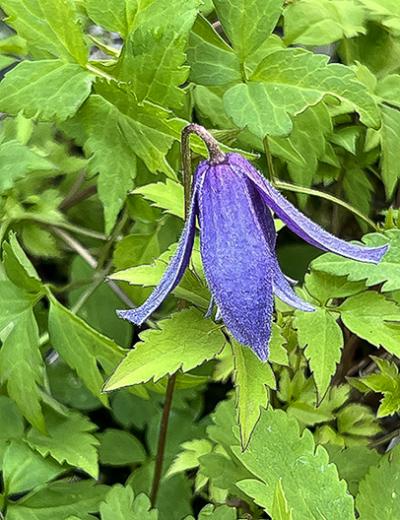
A welcome discovery by Bluebird Nursery staff member, Pam Bahns, this more refined, slower growing sport offers surprising accents of rich burgundy stems and petioles set against a dazzling golden foliar drape. Summer brings chalk white flowers in cheerful frothy masses and papery, pink-flushed white fruit. Shedding a sprightly brilliance upon any lackluster garden setting, the dainty deciduous Lemon Lace Vine can thread its way up a pole in the mixed border, illuminate a fence or intertwine with a Clematis.
Blooms August–September
Size: 15' 0" high x 20' 0" & spreading wide.
Hardy to zone 5.
Ficus
Fig
Selected by plantsman extraordinaire Sean Hogan for its vigorous silver-laced green foliage, aptly named ‘Silver Lyre’ is a probable Ficus afghanistanica hybrid. Drought tolerant upright woody stems soar skyward, dramatically guised with snowflake-shaped rough-to-the touch mercury-hued foliage. While the green-leafed species gallivants throughout northern India, western Iran and Afghanistan, this mesmerizing relatively hardy selection may need some winter protection in our U.S. gardens plus a hot well-drained sunny spot, where it spawns small edible fruit and can be showcased against a dark green setting.
Blooms May
Size: 10' 0" high x 8' 0" wide.
Hardy to zone 7.
x Gordlinia
Mountain Gordlinia
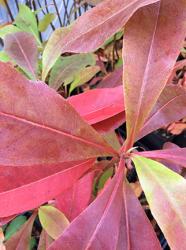
The irresistible brainchild of N.C.S.U. professor Dr. Thomas Ranney, this rare intergeneric cross inherits each of its parents’ finest traits: the hardiness of Franklinia plus Gordonia’s cultural ease. The small attractively shaped visage premiers large 3 to 4 in. wide, slightly cupped white flowers amidst neat reflective linear green leaves that later spark orange and red colors in autumn. From midsummer through early fall, urbane yellow-centered Camellia-like blossoms waft a sweet delicate scent, entrancing butterflies and garden visitors alike. Undaunted by heat and humidity, vigorous Mountain Gordlinia makes a topnotch evergreen specimen in well-drained evenly moist sites with full sun and some light afternoon shade. Large Band.
Blooms July–September
Size: 20' 0" – 30' 0" high x 10' 0" – 15' 0" wide.
Zone 6/7.
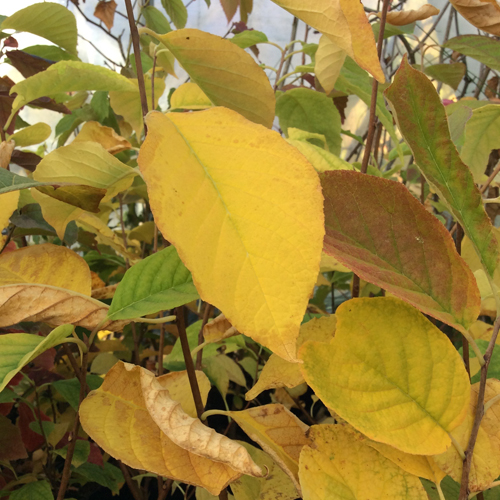
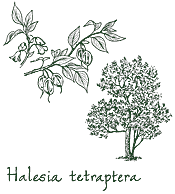
Ringing in spring, clusters of ½ to 1 in. long snow-white bells dangle from Halesia’s graceful branches. The finely serrated, oval leaves provide a flash of yellow in autumn, and the 4-winged brown fruit adds winter interest. With its rounded deciduous form, Halesia is a fine choice for understory shrubs like Hydrangea ‘White Dome’ and Philadelphus ‘Snowbelle’. Thriving in cool, adequately moist, humus-rich soil, we like to position it to be viewed from below. Grows to 12´ in 15 yrs. Large Band.
Blooms May
Size: 11-2/3' – 40' 0" high x 15' 0" – 30' 0" wide.
Hardy to zone 5.
Humulus
Hops
Humulus lupulus ‘Aureus’ (T-0126)
Each $17.75
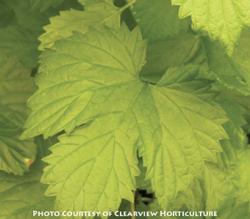
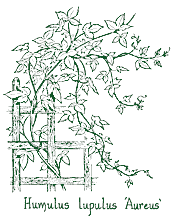
We don’t know how suitable the hops are for brewing, but this lively herbaceous perennial vine lends a nimble twining finery to any tree stump, column, wall or fence. Opposite and textured, the widely-spaced Maple-like leaves open a striking, almost translucent chartreuse, which changes through the season to a lime green. Numerous tiny white flowers are followed by fanciful light green hops in autumn. The stems die down to the ground come winter, but greet each spring with an increasing abundance of new shoots that can grow up to 20´ in a season. Medium Band.
Blooms September
Size: 20' 0" – 30' 0" high x 0" & spreading wide.
Hardy to zone 5.
Hydrangea
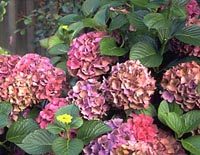
Climbing Hydrangea
The name Hydrangea, means “water vessel,” given for its cup-shaped seed capsules. A genus of diverse forms, Hydrangeas are commonly found throughout Asia, from the Himalayas to Taiwan and Japan, with the exception of 2 species, Hydrangea arborescens and Hydrangea quercifolia, which are native to North America. Easily cultivated, this shrub’s lush deciduous leaves are best suited to loose, moist soil in the shade of tall trees or on the north side of the house.
Hydrangea anomala ssp petiolaris (T-0015)
Each $23.00
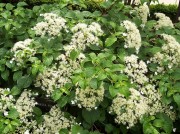
Don’t be put off by the name; this climbing Hydrangea features broad white flower heads, reddish bark, and the glossiest leaves. It produces self-clinging, aerial roots that easily attach to just about anything: pergola, wall, fence or tree, and may need 10 years to reach its full height, but patience pays off with this spectacular deciduous specimen. Meanwhile, enjoy it on a north wall with an understory of Corydalis ‘Blue Panda’ and Geranium ‘Ann Folkard’. Large Band.
Blooms June–July
Size: 60' 0" – 80' 0" high x 0" & spreading wide.
Hardy to zone 5.
Hydrangea anomala ssp. petiolaris ‘Firefly’ (T-0287)
OUT OF PRODUCTION AT THIS TIME
Email me when this plant is available
Looking to add some botanical razzle-dazzle to a hohum shady recess? This mighty variegated vine, introduced by astute horticulturist Dan Banarcik of Chanticleer Gardens, may be your solution. Lustrous deeply serrated dark green leaves flaunt broad golden yellow margins in the spring, which later mellow to a refreshing chartreuse as the weather warms. Iced with lacy white flowers in early summer, the bright deciduous foliage makes a splendid cloak for faithful ‘Firefly’s upright climbing habit. Large Band. (pp#11,038)
Blooms June–July
Size: 30' 0" high x 0" & spreading wide.
Hardy to zone 5.
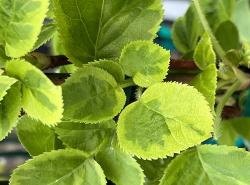
Looking to add some sky-reaching razzle-dazzle to a shady ho-hum recess? This mighty, variegated climber may be your solution. Illuminated by lambent golden-yellow margins in the spring that adopt fresh creamy-chartreuse shades as the weather warms, the serrated heart-style dark green leaves serve as a gleaming deciduous backdrop for airy sparkling white lacecaps. Clinging with aerial rootlets, ‘Miranda’s versatile bushy profile develops layered-looking horizontal branches, showcases attractive exfoliating reddish brown bark in winter and cherishes rich, moist well-drained soil. Medium Band.
Blooms June–July
Size: 30' 0" – 40' 0" high x 0" & spreading wide.
Hardy to zone 4.
Hydrangea anomala ssp. petiolaris ssp. petiolaris ‘Skylands Giant’ (T-0250)
OUT OF PRODUCTION AT THIS TIME
Email me when this plant is available
This sterling cultivar's lustrous, toothed greenery is dappled with choice cream-colored lacy blooms. A luminous standout amid eastward shadows, ‘Skylands Giant’ was selected at the New Jersey Botanical Garden in Skylands for its exceptionally large showy lacecaps, which feature soft-looking centers of tiny fertile flowers ringed by loosely arranged, larger white sterile florets. Large Band
Blooms June – July
Size: 30' 0" high x 0" & spreading wide.
Hardy to zone 4.
Hydrangea integrifolia (T-0138)
Each $22.00
Hailing from the Philippines and Taiwan, this climbing evergreen Hydrangea is seldom seen in cultivation. Rambling, red-hued, hairy stems sport pairs of lustrous elongated leaves, which are so exquisite, it’s easy to wait for the vine to establish itself and produce its intriguing rounded buds and pretty lacy white flowers. A stellar choice for a mild maritime climate or a sheltered wall.
Large Band.
Blooms August
Size: 25' 0" – 30' 0" high x 0" & spreading wide.
Hardy to zone 7.
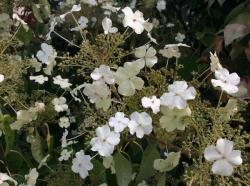
Another rare evergreen climbing form, this vigorous Mexican Hydrangea is quite handsome with its leathery, very shiny, laurel-like dense growth of leaves. Pale green bracts enclose the flower bud, opening to reveal elegant, domed heads circled by a ring of large, white florets. It’s slightly tender, so let it climb over a sheltered wall.
Blooms July–mid-August
Size: 30' 0" high x 0" & spreading wide.
Hardy to zone 7.
Jasminum
Jasmine
Jasminum x stephanense (T-0269)
Each $17.75
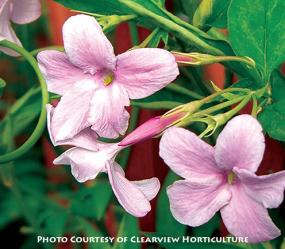
With a divine fragrance that summons up warm exotic places, this robust mostly-evergreen Jasmine is surprisingly hardy. Loose cymes bear deep pink buds and flared, long tubular light pink blooms surrounded by slender angular green shoots and small, ovate-shaped matte green leaves, which are often edged in creamy yellow. Though hybridized in France, it can also be found scrambling throughout the wilds of western China, where both of its parents, Jasminum beesianum and Jasminum officinale, reside. Be sure to provide ample space, cut back or thin out as needed in early spring and situate wherever its sheer beauty and ambrosial aroma can be easily savored. Medium Band.
Blooms May–August
Size: 15' 0" – 20' 0" high x 0" & spreading wide.
Zone 6/7.
Lonicera
Honeysuckle
Entrancing hummingbirds and butterflies, our superb no-fuss selections are hardy, undemanding and appreciative of adequately moist fertile soil. Medium Band.
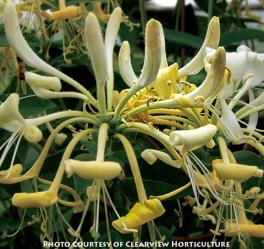
Aptly named and well-worth the wait, this compact highly perfumed cross is the prized outcome of a 10 year breeding program by the Netherlands’ Boskoop Horticultural Research Center. Climbing branches with somewhat rounded, shiny dark green foliage comprise the easily managed bushy growth that boasts a bevy of purplish red buds and clustered tubular blooms, first opening a creamy yellow then darkening to a lovely orange yellow. An award winning cross between Lonicera japonica ‘Halliana’ and Lonicera periclymenum ‘Belgica Select’, ‘Honey Baby’s dwarf evergreen habit can garnish a container, an outdoor living space or a smaller garden, while its delectable smelling flowers unfurl from summer ’til fall. Medium Band.
Blooms July–October
Size: 4' 0" – 6' 0" high x 0" & spreading wide.
Hardy to zone 4.
Lonicera periclymenum ‘Belgica’ (T-0268)
Each $17.75
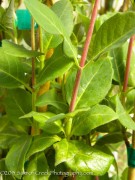
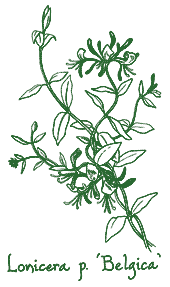
Heralding summer, this energetic sweetly scented twiner blooms earlier than most Honeysuckles and is set apart by tubular flowers, whose interiors change color as they mature amid oval semideciduous green leaves. Sprightly deep pink clusters of long slender curling buds open into large crimson bugles with creamy-white centers, which later showcase bright yellow and red shades. Especially fragrant at the end of the day, ‘Belgica’ can be pruned to develop a shrubby bearing or be encouraged to ramble up walls, trellises, pillars, the branches of large shrubs or a Cercidiphyllum. Medium Band.
Blooms May–August
Size: 6' 0" – 8' 0" high x 0" & spreading wide.
Hardy to zone 5.
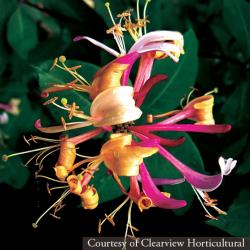
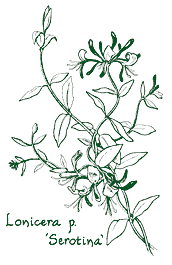
Samuel Pepys called it the trumpet flower and wrote, “The bugles blow scent instead of sound.” ‘Serotina’ bears multitudes of spidery-looking, fuchsia-colored buds, which open into pink, sweet-smelling bugles that later fade to a creamy salmon color. You can prune this vigorous semideciduous vine to make it more shrublike or let its bluish green foliage climb into the branches of a Cercidiphyllum.
Blooms June–September
Size: 6' 0" – 8' 0" high x 4' 0" wide.
Hardy to zone 6.
Introduced to the western world in 1900 by esteemed plant explorer E. H. Wilson, this magnificent deciduous Honeysuckle is unique for its shade-loving constitution and sensational, 3 in. long bright golden yellow trumpets. Though the large terminal clusters are not fragrant, each hosts 10 to 20 flashy flowers amid red-flushed buds and appealing good-sized blue-green leaves that burnish purple. Chinese Honeysuckle’s young robust stems can be trimmed immediately after blooming to promote a tidy, easily managed low maintenance framework plus flowers galore.
Blooms June–August
Size: 12' 0" – 20' 0" high x 0" – 55-1/2' wide.
Hardy to zone 6.
OUT OF PRODUCTION AT THIS TIME
Email me when this plant is available
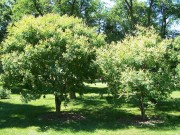
Honoring the 19th century Russian naturalist, Karlovich Maack, this handsome, yet resilient small-sized Asian native has championed four-season allure since it was first introduced in 1864. Five to seven silvery green deciduous leaflets define attractive locust-style compound leaves, which mature to olive green on a broad, slow growing rounded framework of stiff interlacing branches and lustrous curly exfoliating bark with warm coppery tan shades. Heightened by pale slate blue hues, fragrant porcelain-colored pea-like flowers densely populate the showy upright clustered racemes; flat brown 2 to 3 in. long pods follow.
An obliging easy-care specimen for lawns, patios, large vessels or sidewalks, the little-known Amur Maackia touts natty good looks, favors a sunny well-drained setting, and promotes beneficial nitrogen-fixing bacteria on its roots. Grows slow to moderately. Medium Band.
Blooms June/July.
Size: 20' 0" – 30' 0" high x 20' 0" – 30' 0" wide.
Hardy to zone 3.
Adored by gardeners as well as birds, bees and butterflies, this lavish semi-deciduous vine delivers alluring tropical accents plus a heady vanilla perfume. Tubular and clustered, large flared snowy white blossoms measuring 2 ½ in. across grace a spirited glossy backdrop of slender twining stems and heart-shaped 6 in. long bright green leaves. Well-suited for container culture in northern zones and warm sunny protected niches elsewhere, long blooming Mandevilla laxa relishes rich soil, requires periodic cutbacks, needs less heat to flower than other species and calls Argentina and Bolivia its native home.
Blooms June–August.
Size: 10' 0" – 15' 0" high x 0" & spreading wide.
Hardy to zone 9.
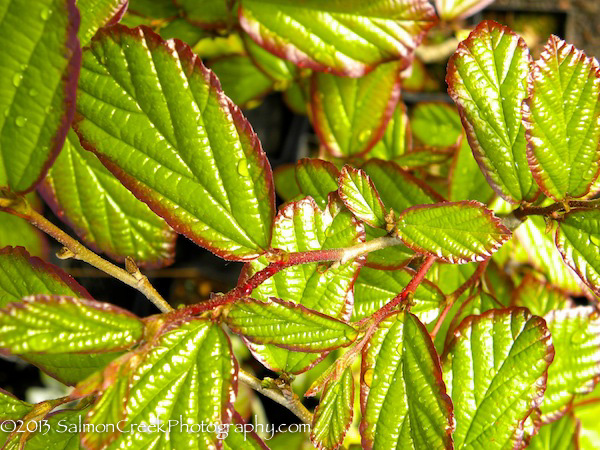
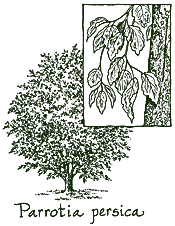
F. W. Parrot, who made the first ascent of Mt. Ararat in 1829, lends his name to this low-branched, round-headed deciduous Iranian native with remarkable landscape merit. In spring, the silver, green and cream-hued smooth bark is complemented by glistening green foliage and in autumn it’s highlighted by radiant gold, rosy-pink and crimson tones. Later, showy red stamens and woolly brown bracts create a reddish haze around bare limbs, crafting a virtual carousel of color and texture. Pest-free Persian Ironwood prefers well-drained soil and detests both overly wet or dry conditions. Grows moderately. 10´ in 6–8 yrs. Large Band.
Blooms March
Size: 15' 0" – 35' 0" high x 15' 0" – 30' 0" wide.
Hardy to zone 5.
Parrotia persica ‘Vanessa’ (T-0332)
Each $31.75
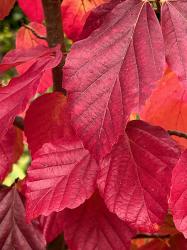
A versatile award-winning cultivar, ‘Vanessa’ offers year-round enticements. The tidy, upright-pyramidal habit is distinguished by close-knit branches clad with handsome deciduous foliage that boasts a splendid fall finale of brilliant red, gold, plum and tangerine shades. For winter appeal, exfoliating bark reveals gray, green and cream-hued tapestry-like patches, while bee-friendly maroon-colored flowers lend an overall intriguing aspect before the leaves appear. Whether embellishing beds, borders, cottage gardens or open woodlands as a showy specimen, it’s at home in modern, informal or traditional settings. This easy-care, pest-resistant tree appreciates sunny and well-drained, moderately fertile sites, yet endures dappled shade, variable soil types plus city pollution. 10´ in 6–8 yrs. Large Band.
Blooms March
Size: 15' 0" – 40' 0" high x 10' 0" – 20' 0" wide.
Hardy to zone 4.
Passiflora
Passion Flower
Hailing from South America, Passifloras entertain dazzling flower parts that attract butterflies and plant lovers, and in the Catholic faith once symbolized Jesus’ last day. These wildly vivacious and floriferous semievergreen climbers appreciate sun, heat and good air circulation as well as cold protection around 18 degrees plus free-draining, somewhat dry sandy soil with moderate fertility. Frequent trimming will encourage branching, while a cool greenhouse or warm masonry wall will ensure their winter survival.
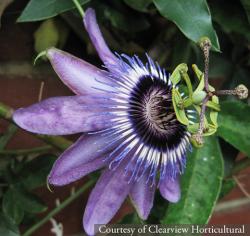
Named for his mother, this Passiflora ‘Clear Sky’ x Passiflora loefgrenii ‘Iporanga’ cross was made by Passiflora aficionado Myles Irvine in 2005. Unleashed against hearty dark green lobed leaves and winding tendrils, astonishing quantities of 30 or 40 slightly reflexed, 3 to 4 in. wide dusky purple flowers appear each day. Maroon and green centers coupled with striking slender pointed filaments, each sporting a smoky blue tip, white halo and a dark midnight blue base embellish the stylish lightly scented blooms. Considered by many to be the foremost garden-worthy Passiflora currently available, ‘Betty Myles Young’ is a robust polyploid hybrid that lends a winsome glossy presence to trellises, protected walls or containers.
Blooms June–October
Size: 10' 0" – 15' 0" high x 0" & spreading wide.
Zone 8b.
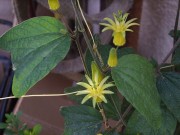
Perhaps the only yellow blooming hummingbird pollinated Passiflora in the world, this exquisite freeflowering climber can be relished inside or out. Dozens of bright lemon-colored starry blossoms festoon an easy-to-manage, highly welcome diminutive stature that's draped with small bilobed evergreen leaves. Sauntering around Guatemala and Honduras, where John MacDougal first spotted it in 1989, Passiflora citrina is a stellar contender for containers, sun-basked windowsills, hanging baskets and tight garden spots. Bright light, average moisture, almost any moderately fertile soil and night temperatures exceeding 25° keep the flowers coming. Medium Band.
Blooms April – September
Size: 10' 0" high x 0" & spreading wide.
Hardy to zone 9.
Passiflora x ‘Lavender Lady’ (T-0319)
Each $15.75
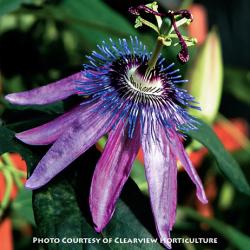
Myriad 4 in. wide violet flowers set against a lush, mighty mantle of twining stems and hardy 3-lobed green leaves make an out-of-this world nearly year-round showing. Garnished with fringe-like inky-purple filaments, green anthers plus white centers, the jewel-box blooms impart a unique glowing translucence that entices butterflies and plant lovers alike. Patrick Worley’s 1982 brainchild, this Passiflora amethystina and Passiflora caerulea cross is known to survive temperatures as low as 15°, making it the go-to choice for northerly gardeners as well as those craving long-lasting purple flower-power.
Blooms June–October
Size: 15' 0" – 18' 0" high x 0" & spreading wide.
Zone 8a.
Passiflora ‘Snow Queen’ (T-0313)
Each $15.75
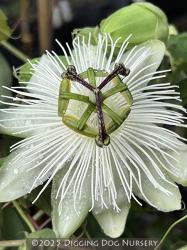
Parented by Passiflora caerulea and Passiflora ‘White Wedding’, this award-winning 2011 Myles Irvine introduction is a polyploid hybrid debuting a prolific warm weather gala of luxe pure white flowers amid handsome glossy greenery. Each fragrant, 3 to 4 in. wide blossom remains open for several days and features long, ultrafine pointed filaments, hooked outer petals plus 3 bold purple-spotted stigmas. ‘Snow Queen’s quick-to-establish root system supports a peppy habit with twining tendrils and large, veined, palmately lobed leafage. (pp#29,608)
Blooms June–October
Size: 16' 0" high x 0" & spreading wide.
Zone 8b.
The prized 2002 British outcome of the ‘Star of Bristol’ and ‘Purple Haze’ cross by Englishman Myles Irvine, this moderately vigorous evergreen vine musters untold quantities of stylish, lightly perfumed 5 in. wide blooms. The stellar, long-lasting pure white petals gather around a large corona, each with bright bluish purple filaments and a soft pink center. More cold tolerant than our other Passiflora offerings, easily cultivated ‘Star of Surbiton’ handles full sun and temperatures down to approximately 18°, while enjoying warm mulched abodes, either in the ground or in a favored vessel.
Blooms June–December
Size: 6' 0" – 12' 0" high x 0" & spreading wide.
Zone 8b.
Passiflora ‘Susan Brigham’ (T-0307)
OUT OF PRODUCTION AT THIS TIME
Email me when this plant is available
Cherished by butterflies, especially Gulf Fritillaries, this luscious mixta x manicata hybrid pays homage to breeder Pat Worley’s mother. Full-toned magenta blooms with bright yellow anthers grow up to 6 in. wide amongst long hefty stems and enormous, 3-lobed gleaming dark greenery. A robust undemanding vine that needs plenty of space, prismatic ‘Susan Brigham’ relishes moderate water, bright dappled light, rich well-drained soil, as well as shelter from temperatures lower than 30˚.
Blooms June–October
Size: 12' 0" – 15' 0" high x 0" & spreading wide.
Hardy to zone 9.
Pinus
Pine
OUT OF PRODUCTION AT THIS TIME
Email me when this plant is available
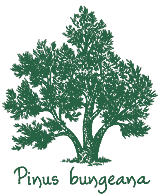
Discovered by the Russian collector, Dr. Alexander von Bunge in 1831 on the grounds of a Buddhist temple near Beijing, this medium-sized hardy pine emphasizes mesmerizing details throughout the year: artful mottled bark, dapper grassy green needles and an airy picturesque silhouette. The ornamental exfoliating bark peels back to reveal an extraordinary tapestry of silvery white, olive green and pale purple splotches amidst 4 in. long rigid needles, arranged in bundles of 3, and small amber brown cones.
Branching near its base, Lacebark Pine grows slowly into a stylish multitrunked specimen with a broad, sometimes shrubby, spreading form that enjoys sunny well-drained sites. Grows slowly. Medium Band.
Size: 20' 0" – 45' 0" high x 20' 0" – 35' 0" wide.
Hardy to zone 4.
Pinus thunbergii var. Mikawa var. Mikawa (T-0258)
OUT OF PRODUCTION AT THIS TIME
Email me when this plant is available
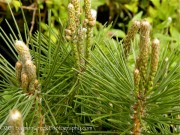
Championed by artists and bonsai aficionados for centuries, this distinctive Pine spotlights pairs of nearly white new growth, thick rigid needles, corky purplish black bark, and stout twisting horizontal branches that can sustain just about any amount of pruning or trimming. Mikawa’s rugged naturally dwarfed trunk crafts an exquisite bonsai specimen, while acquiescing to con-tainer culture, salt spray and poor sandy soil. Grows very slowly.
Medium Band.
Size: 5' 0" high x 2' 0" wide.
Hardy to zone 5.
OUT OF PRODUCTION AT THIS TIME
Email me when this plant is available
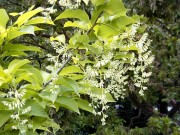
Here’s a hard-to-find ornamental tree named for its extravagance of creamy white, fringy flowers that dangle in fragrant, drooping clusters 9 in. long and 4 in. wide. Branching low with a widespreading, but upswept habit, this deciduous tree develops a teardrop form if the lowest branches are retained.
The light green leaves, gray-green beneath, offer yellow fall color that persists for some time, and contrasts nicely with the gray snakeskin bark, enhanced by orange-tan streaks. Shown to advantage on the bare branches of winter, clusters of small, fuzzy gray fruit are a bonus in arrangements. Aside from its year-round loveliness, which is best viewed in an elevated position, Epaulette Tree can tolerate wind, and clay or sandy soil. Large Band.
Blooms June
Size: 15' 0" – 20' 0" high x 10' 0" – 40' 0" wide.
Hardy to zone 5.
Schizophragma
Japanese Hydrangea Vine
Who wouldn’t want a Schizophragma in their garden if only because it’s such a fun word to say? This genus of tall growing deciduous vines and showy flowers is little known in the U.S., but in the deep forest outside Hokkaido, Japan it grows everywhere. Try planting your Japanese Hydrangea Vine at the base of a wall or a tree trunk and watch it climb!
Large Band.
Schizophragma hydrangeoides ‘Moonlight’ (T-0115)
Each $23.00
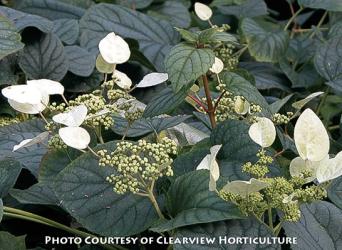
Ringed with porcelain-colored bracts, the grand lacy white flowers of this hard-to-find cultivar can grow up to 9 in. across. ‘Moonlight’ is distinguished by its striking heart-shaped leaves, whose deep green veins and silvery overlays create an intriguing pattern, and in autumn turn orange red. Perfect for the north side of the house, this vine promises to illuminate a shady area. Large Band.
Blooms July–August
Size: 30' 0" – 40' 0" high x 0" wide.
Hardy to zone 5.
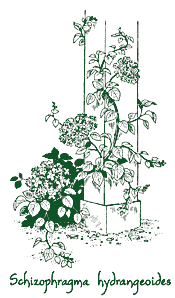
‘Rosea’ displays a splendid habit with interest in every aspect: rose-blushed bracts, mahogany stems, red-hued leaf petioles and handsome, toothed dark green foliage. Each thick, richly textured deciduous leaf is polished and grows in an elongated heart shape. This climbing Hydrangea will dress up a somber wall in your garden. Medium Band.
Blooms July–August
Size: 0" high x 0" – 40' 0" wide.
Hardy to zone 5.
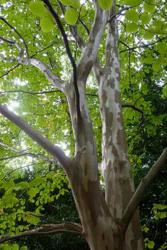
Some 200 years ago, at the opening of Kew Gardens, John Stuart, Earl of Bute, presented a Stewartia to the Welsh Princess Augusta; the honor was somewhat skewed by the misspelling of the Earl’s name. His choice is still prized for its year-round attributes. Orange, gray and reddish brown exfoliating bark bestows an extraordinary winter aspect, while the magnificent bee-friendly profusion of cupped, yellow-centered, white flowers resembles Camellias, appearing in summer when few woody plants are blooming. Finely toothed, bright green leaves transmute deep bronze and purple-red autumnal colors. Unparalleled when planted in a grove, by a sitting area or as a focal point, Japanese Stewartia requires ample moisture, good drainage, lime-free soil and protection from hot sun as well as wind. Grows slowly.
Blooms late-July–August
Size: 22' 0" high x 12' 0" wide.
Hardy to zone 5.
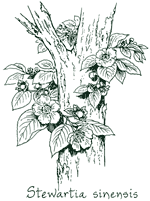
This small shrubby Chinese denizen vaunts a lot of four-season luxe: copious cup-shaped white flowers, fabulous exfoliating bark and handsome toothed dark green leaves, which brandish bronze-toned new growth plus bright crimson fall color. Exquisite camellia-like scented blooms line upward arching branches, while long artful cinnamon-colored strips peel off, revealing a marble-smooth light rosy tan finish beneath. Ideal for a small garden, courtyard, informal setting or a woodland’s edge, Chinese Stewartia can be ensconced amid Oakleaf Hydrangeas and skirted by swaths of Sesleria and Calamagrostis foliosa. A protected, yet somewhat bright abode with acidic well-drained, humus-rich soil ensures its vitality. Grows moderately
Large Band
Blooms July–August
Size: 15' 0" – 25' 0" high x 10' 0" – 15' 0" wide.
Hardy to zone 5.
Styrax
Snowbell
Each $27.75
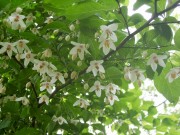
Often twice as broad as it is high, this adored Japanese denizen models an enchanting form: strongly horizontal curving branches with a slightly flat crown. Refined, subtly fragrant white “snowbells” hang down, while the leaves angle upward, allowing the delicate flowers to be easily viewed. Set against mottled gray bark, the lustrous, fine textured rich green foliage casts light shade in summer and flashes red or yellow tones in autumn. A definitive specimen tree, Japanese Snowbell can be situated near a patio, in a raised bed or on a high bank, where it can be relished from below. Well-drained, loamy soil that’s lime free plus adequate moisture allow it to flourish. Grows moderately. Large Band.
Blooms May–June
Size: 25' 0" high x 25' 0" wide.
Hardy to zone 5.
Syringa
Tree Lilac
Syringa reticulata ssp. pekinensis (T-0283)
OUT OF PRODUCTION AT THIS TIME
Email me when this plant is available
Promising year-round beauty, this small rounded Morton Arboretum selection debuts large fragrant creamy white flowers followed by open clusters of warm brown capsules, artful cinnamon-colored exfoliating bark and attractive dark greenery. Indigenous to northern China's hills and valleys, and named for the distinctive net veining or reticulata that embellishes its ovate leaves, cold-hardy Peking Lilac sculpts an upright multistemmed open frame with courtly arching branches. Ideal for urban settings, except those in the deep south, this star specimen triumphs over clay or deer, and readily flourishes where cool summers, adequate air circulation, average water and slightly acidic rich well-drained soil prevail. Large Band.
Blooms June
Size: 15' 0" – 20' 0" high x 10' 0" – 15' 0" wide.
Hardy to zone 3.
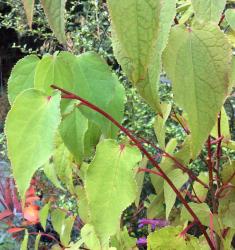
A 1901 introduction by the eminent plant hunter E. H. Wilson and a singular species in its own genus, this rare, elegant small tree hails from China. Tetracentron sinense fashions a broad deciduous canopy of gracefully arching branches draped with alternate, rounded heart-shaped leaves, which adopt new red growth in spring, serrated margins, textured palmate veins plus an overall Cercidiphyllum-like appearance. Minute clustered yellowish green flowers densely populate pendulous catkin-like spikes for summer intrigue, while orange and cardinal tones signal autumn. Favoring well-drained soil, light dappled shade and a sheltered spot, but sulking during hot humid summers, Chinese Tetracentron can be planted as a suave deciduous specimen in a lawn area or near a patio. Grows moderately
Large Band
Blooms June–July
Size: 12' 0" – 20' 0" high x 8' 0" – 13' 0" wide.
Hardy to zone 6.
Trachelospermum asiaticum ‘Theta’ (T-0293)
Each $17.75
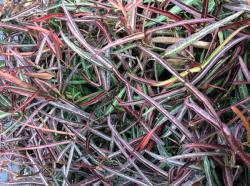
Acclaimed for its long lean dark green foliage, presenting lustrous surfaces and luminous silver midribs, this distinctive Jasmine was selected by Cistus nursery proprietor Sean Hogan and named after his mother. Delectably scented pinwheel-shaped creamy white blossoms appear in droves all summer amid a handsome cold hardy evergreen habit that looks a bit like bamboo. Gifted with versatility galore, ‘Theta’ can scramble up a trellis, ramble around as a ground cover, tumble down walls or gracefully spill over a container’s edge. Appropriate pruning, moderate moisture, dappled light during intense heat and warm west-facing sun-drenched spots assure strong enduring growth.
Blooms May–June
Size: 8' 0" high x 4' 0" wide.
Hardy to zone 7.
Vitis
Grape
OUT OF PRODUCTION AT THIS TIME
Email me when this plant is available
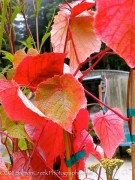
Native to Japan and Korea—and absolutely fantastic! We love the grapes’ dramatic architecture and, in our garden, we’ve dedicated some substantial earthen columns to Crimson Glory Vine’s rampant blaze. Capable of filling an expanse, its very large (up to 10 to 12 in.), lobed and heart-shaped leaves are felted beneath in a rich rusty hue, providing a winsome palette for the display of diminutive greenish flowers that develop into clusters of beloved-by-birds purple-black fruit. A satisfying grayish green through the summer, deciduous leaves spark to flaming shades of scarlet and amber as fall sets in. Easy-to-grow Glory Vine’s color intensifies in slightly dry soil where its roots are somewhat restricted. Quart.
Blooms June
Size: 0" – 50' 0" high x 0" & spreading wide.
Hardy to zone 5.
Wisteria ‘Amethyst Falls’ (T-0259)
Each $25.00
Gracefully cascading in opulent 2 to 4 in. compact racemes amid shiny bronze-tinged new growth, ‘Amethyst Falls’ earns its name. The fragrant, pealike, vivid lavender-hued flowers unfurl some two weeks earlier than their Asian relatives and if lightly pruned will produce a summer encore. A slew of twining stems and airy pinnate foliage composed of green oval-shaped leaflets can be trained up a pergola or a trellis and as a free-standing tree form.
An improved selection of our native American Wisteria, this noninvasive, award winning cultivar exhibits an easily controlled less aggressive habit, which withstands deer, most diseases and some drought, doesn’t fuss about soil fertility and relishes good drainage. Large Band.
Blooms late April – May & September
Size: 20' 0" – 25' 0" high x 0" & spreading wide.
Hardy to zone 5.
Wisteria frutescens ‘Aunt Maude’ (T-0299)
Each $22.50
If you’re smitten with Wisteria but searching for one that’s not so unruly, you may be interested in this superior southeastern U.S. native. Splendid close-knit clusters of 30 to 50 delicately fragrant blue-violet flowers garnish the current season’s growth, unfurling throughout the summer. Amongst large ovate green deciduous leaflets, the lovely cascading blossoms are followed by long lustrous seedpods that lend late season interest. Easier to manage and more hardy than her Asian counterparts, ‘Aunt Maude’ cloaks walls, trellises and columns with her long lasting floral charm. (pp#20,006)
Quart
Blooms June–July
Size: 12' 0" – 18' 0" high x 0" & spreading wide.
Hardy to zone 4.
Wisteria macrostachya ‘Blue Moon’ (T-0270)
Each $26.00
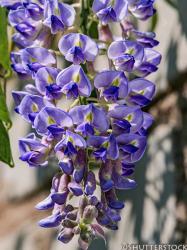
A floriferous noninvasive selection of the south-central U.S. native Wisteria macrostachya, ‘Blue Moon’s lavish 12 inch long racemes are populated by pea-style, sweetly scented lavender-blue flowers that make grand additions to cut arrangements. Spectacular repeat bloom periods, pendulous velvet-like seed pods, counterclockwise twining stems, attractive compound dark green leaves and superb winter hardiness characterize the mighty fast-growing habit. Unparalleled for sturdy structures such as arbors, columns, pergolas or free-standing garden walls, this long-lived deciduous vine shuns deer, nourishes pollinators and prefers humus-rich, slightly acidic fertile soil with adequate moisture plus good drainage. Large Band.
Blooms June
Size: 15' 0" – 25' 0" high x 4' 0" – 8' 0" wide.
Hardy to zone 3.










